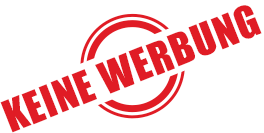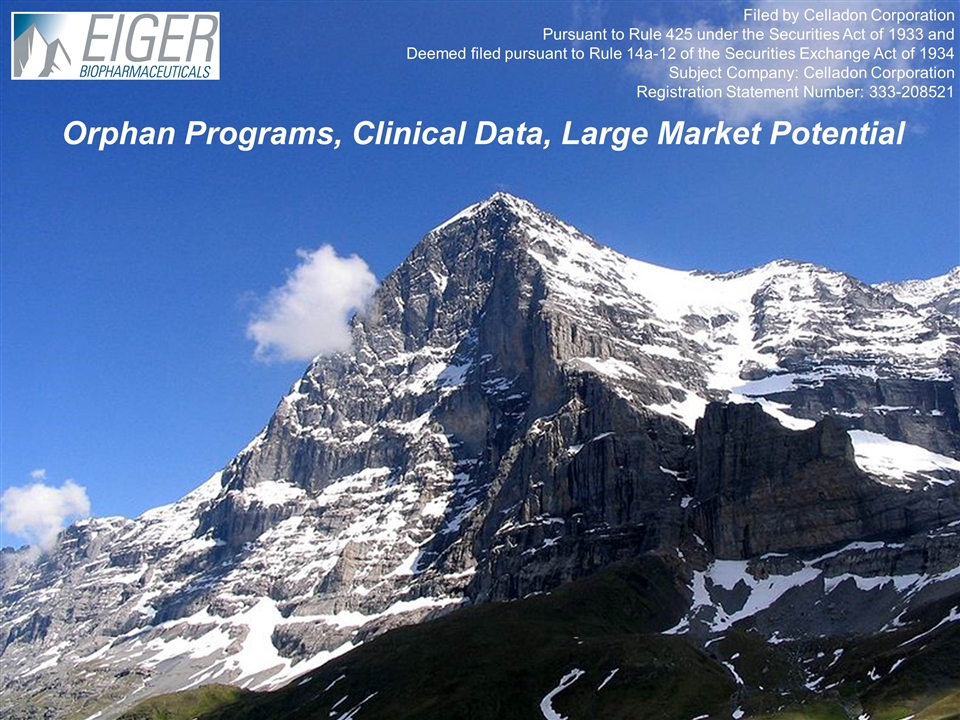
Orphan Programs, Clinical Data, Large
Market Potential Filed by Celladon Corporation Pursuant to Rule 425 under the Securities Act of 1933 and Deemed filed pursuant to Rule 14a-12 of the Securities Exchange Act of 1934 Subject Company: Celladon Corporation Registration Statement Number:
333-208521
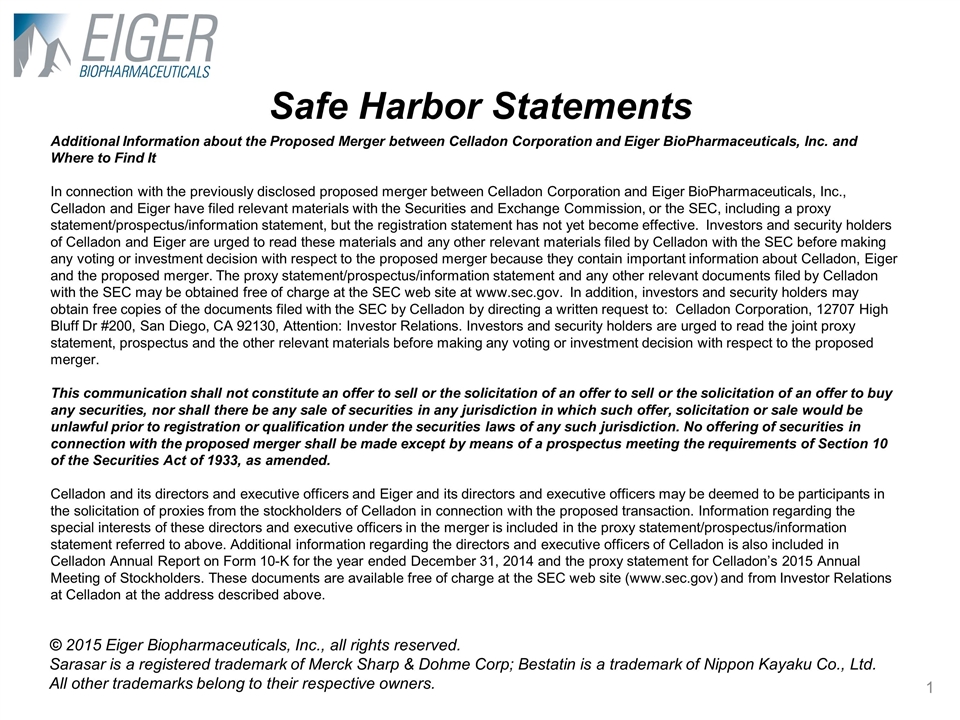
Safe Harbor Statements Additional
Information about the Proposed Merger between Celladon Corporation and Eiger BioPharmaceuticals, Inc. and Where to Find It In connection with the previously disclosed proposed merger between Celladon Corporation and Eiger BioPharmaceuticals, Inc.,
Celladon and Eiger have filed relevant materials with the Securities and Exchange Commission, or the SEC, including a proxy statement/prospectus/information statement, but the registration statement has not yet become effective. Investors and
security holders of Celladon and Eiger are urged to read these materials and any other relevant materials filed by Celladon with the SEC before making any voting or investment decision with respect to the proposed merger because they contain
important information about Celladon, Eiger and the proposed merger. The proxy statement/prospectus/information statement and any other relevant documents filed by Celladon with the SEC may be obtained free of charge at the SEC web site at
www.sec.gov. In addition, investors and security holders may obtain free copies of the documents filed with the SEC by Celladon by directing a written request to: Celladon Corporation, 12707 High Bluff Dr #200, San Diego, CA 92130, Attention:
Investor Relations. Investors and security holders are urged to read the joint proxy statement, prospectus and the other relevant materials before making any voting or investment decision with respect to the proposed merger. This communication shall
not constitute an offer to sell or the solicitation of an offer to sell or the solicitation of an offer to buy any securities, nor shall there be any sale of securities in any jurisdiction in which such offer, solicitation or sale would be unlawful
prior to registration or qualification under the securities laws of any such jurisdiction. No offering of securities in connection with the proposed merger shall be made except by means of a prospectus meeting the requirements of Section 10 of the
Securities Act of 1933, as amended. Celladon and its directors and executive officers and Eiger and its directors and executive officers may be deemed to be participants in the solicitation of proxies from the stockholders of Celladon in connection
with the proposed transaction. Information regarding the special interests of these directors and executive officers in the merger is included in the proxy statement/prospectus/information statement referred to above. Additional information
regarding the directors and executive officers of Celladon is also included in Celladon Annual Report on Form 10-K for the year ended December 31, 2014 and the proxy statement for Celladon’s 2015 Annual Meeting of Stockholders. These
documents are available free of charge at the SEC web site (www.sec.gov) and from Investor Relations at Celladon at the address described above. © 2015 Eiger Biopharmaceuticals, Inc., all rights reserved. Sarasar is a registered trademark of
Merck Sharp & Dohme Corp; Bestatin is a trademark of Nippon Kayaku Co., Ltd. All other trademarks belong to their respective owners.
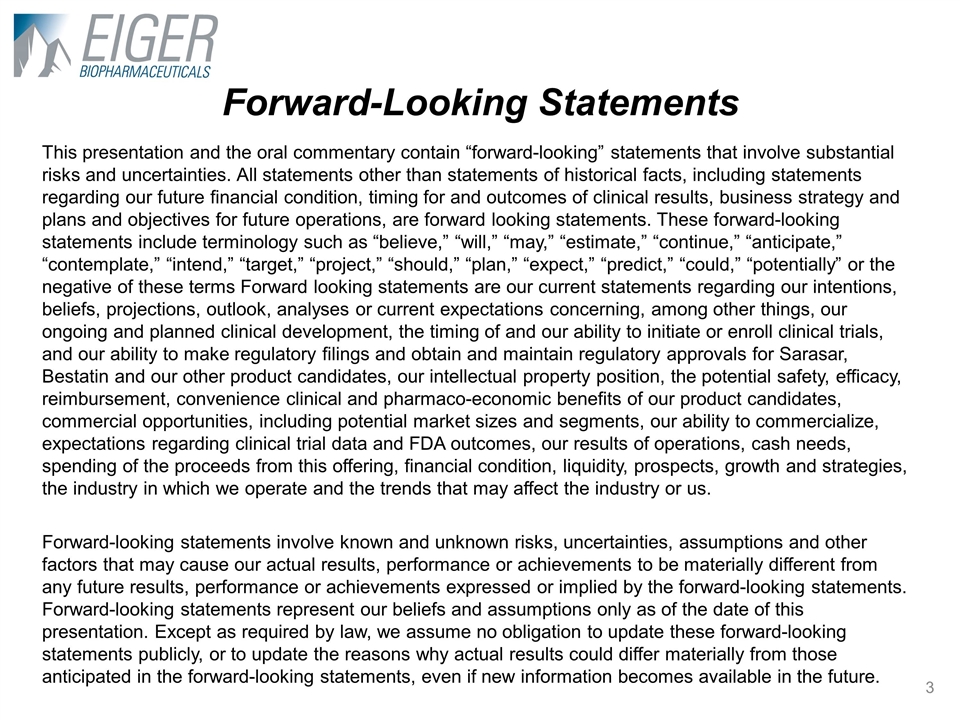
This presentation and the oral commentary
contain “forward-looking” statements that involve substantial risks and uncertainties. All statements other than statements of historical facts, including statements regarding our future financial condition, timing for and outcomes of
clinical results, business strategy and plans and objectives for future operations, are forward looking statements. These forward-looking statements include terminology such as “believe,” “will,” “may,”
“estimate,” “continue,” “anticipate,” “contemplate,” “intend,” “target,” “project,” “should,” “plan,” “expect,”
“predict,” “could,” “potentially” or the negative of these terms Forward looking statements are our current statements regarding our intentions, beliefs, projections, outlook, analyses or current expectations
concerning, among other things, our ongoing and planned clinical development, the timing of and our ability to initiate or enroll clinical trials, and our ability to make regulatory filings and obtain and maintain regulatory approvals for Sarasar,
Bestatin and our other product candidates, our intellectual property position, the potential safety, efficacy, reimbursement, convenience clinical and pharmaco-economic benefits of our product candidates, commercial opportunities, including
potential market sizes and segments, our ability to commercialize, expectations regarding clinical trial data and FDA outcomes, our results of operations, cash needs, spending of the proceeds from this offering, financial condition, liquidity,
prospects, growth and strategies, the industry in which we operate and the trends that may affect the industry or us. Forward-looking statements involve known and unknown risks, uncertainties, assumptions and other factors that may cause our actual
results, performance or achievements to be materially different from any future results, performance or achievements expressed or implied by the forward-looking statements. Forward-looking statements represent our beliefs and assumptions only as of
the date of this presentation. Except as required by law, we assume no obligation to update these forward-looking statements publicly, or to update the reasons why actual results could differ materially from those anticipated in the forward-looking
statements, even if new information becomes available in the future. Forward-Looking Statements 3
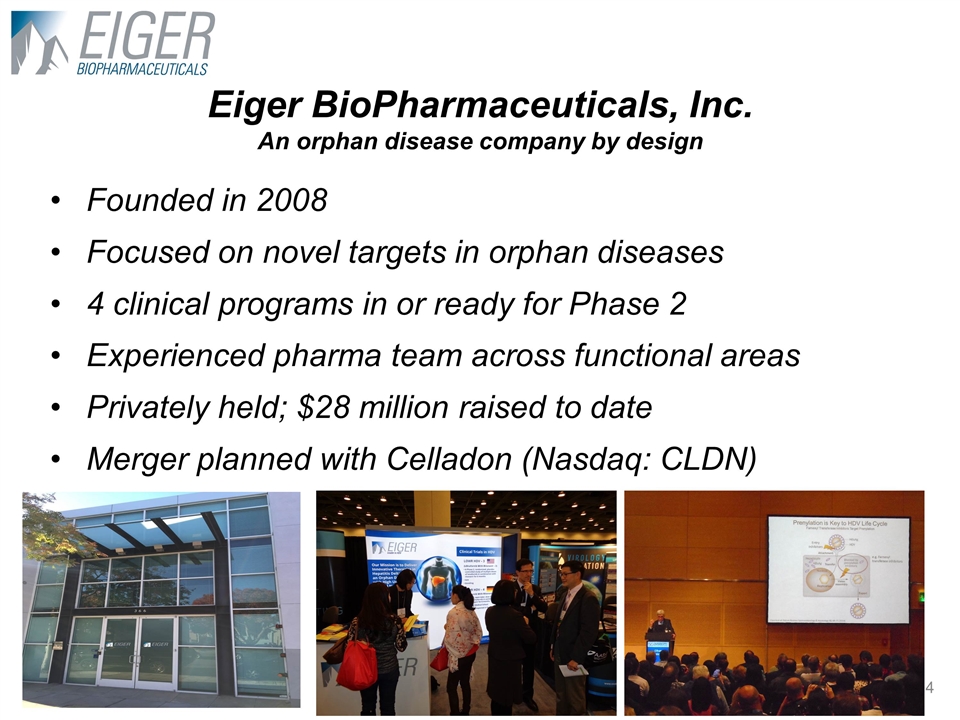
Eiger BioPharmaceuticals, Inc. An orphan
disease company by design Founded in 2008 Focused on novel targets in orphan diseases 4 clinical programs in or ready for Phase 2 Experienced pharma team across functional areas Privately held; $28 million raised to date Merger planned with Celladon
(Nasdaq: CLDN)
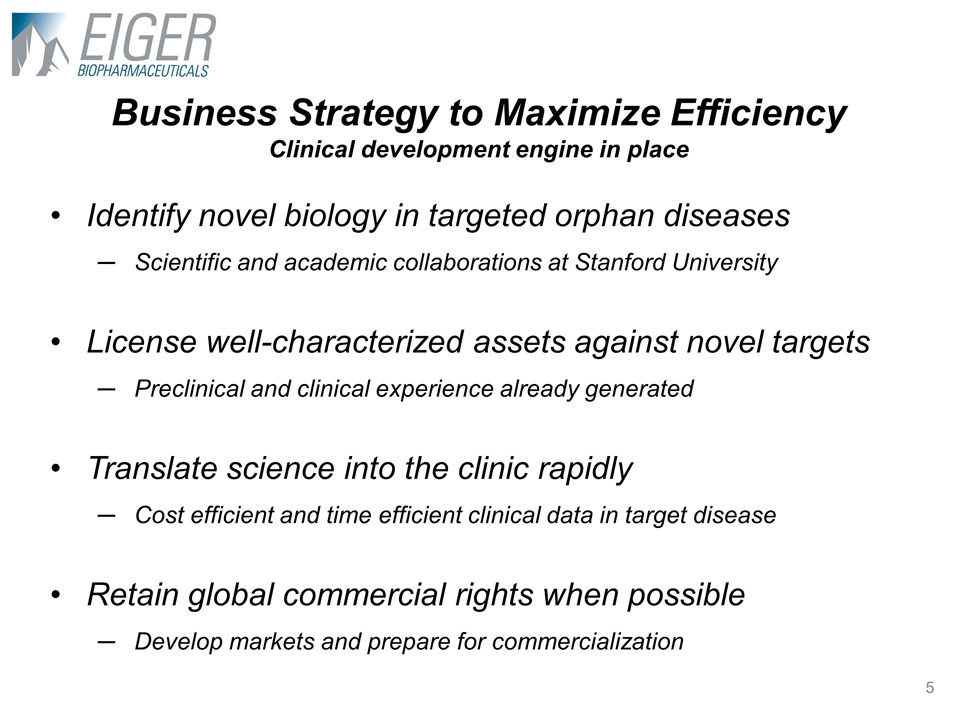
Business Strategy to Maximize Efficiency
Clinical development engine in place Identify novel biology in targeted orphan diseases Scientific and academic collaborations at Stanford University License well-characterized assets against novel targets Preclinical and clinical experience already
generated Translate science into the clinic rapidly Cost efficient and time efficient clinical data in target disease Retain global commercial rights when possible Develop markets and prepare for commercialization
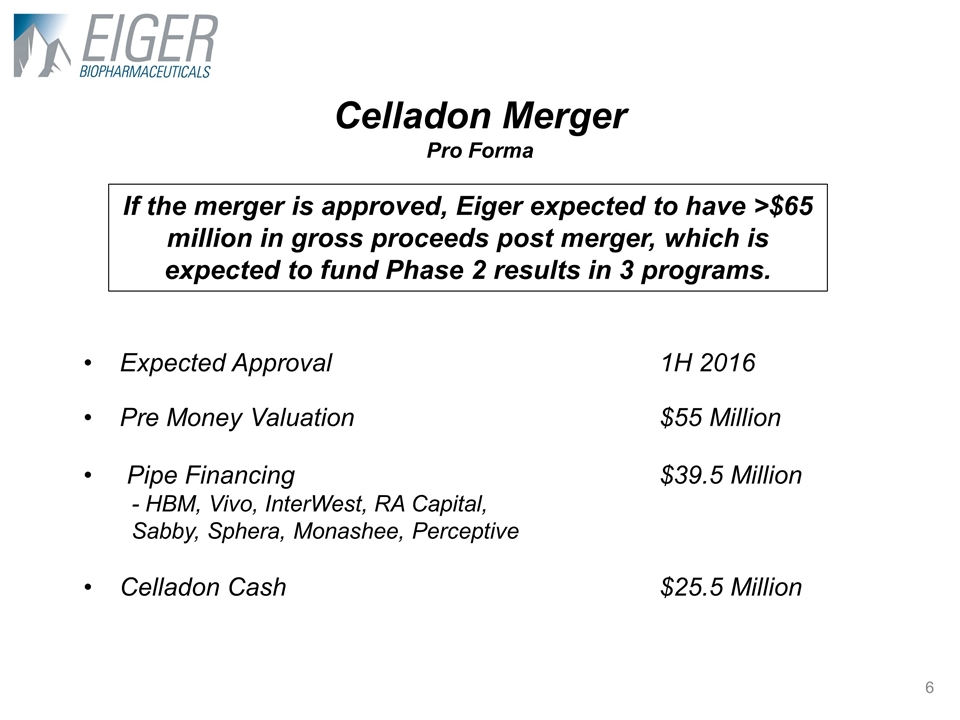
Celladon Merger Pro Forma Expected
Approval1H 2016 Pre Money Valuation$55 Million Pipe Financing $39.5 Million - HBM, Vivo, InterWest, RA Capital, Sabby, Sphera, Monashee, Perceptive Celladon Cash$25.5 Million If the merger is approved, Eiger expected to have >$65 million in gross
proceeds post merger, which is expected to fund Phase 2 results in 3 programs. 6
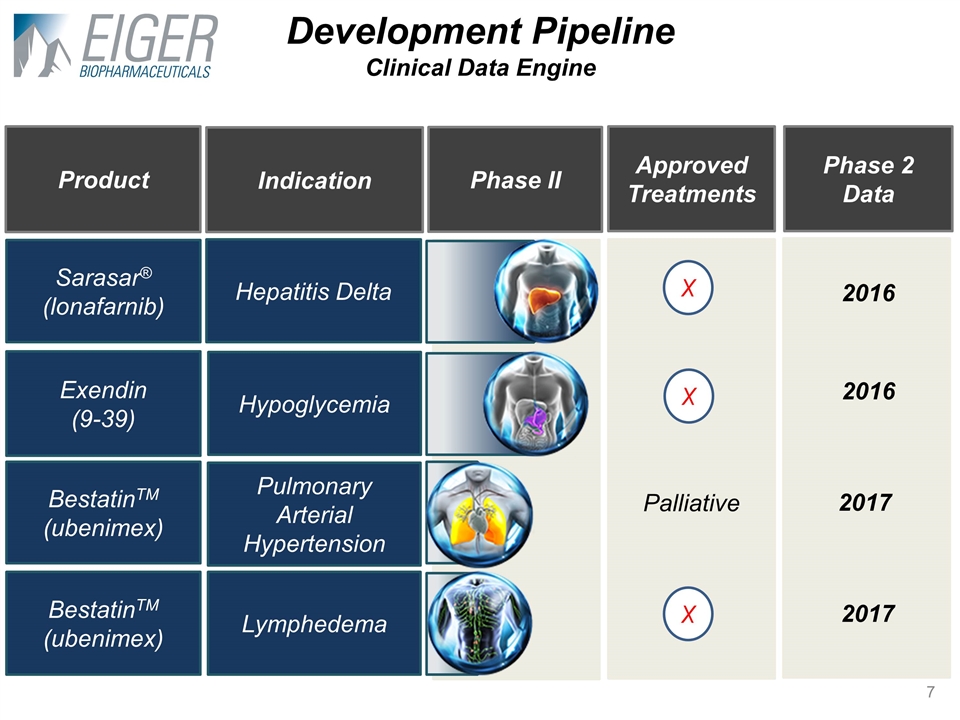
Phase 2 Data Hepatitis Delta Hypoglycemia
Pulmonary Arterial Hypertension Lymphedema Sarasar® (lonafarnib) Exendin (9-39) BestatinTM (ubenimex) BestatinTM (ubenimex) Palliative X X X 2016 2016 2017 2017 Development Pipeline Clinical Data Engine Indication Phase II Approved Treatments
Product
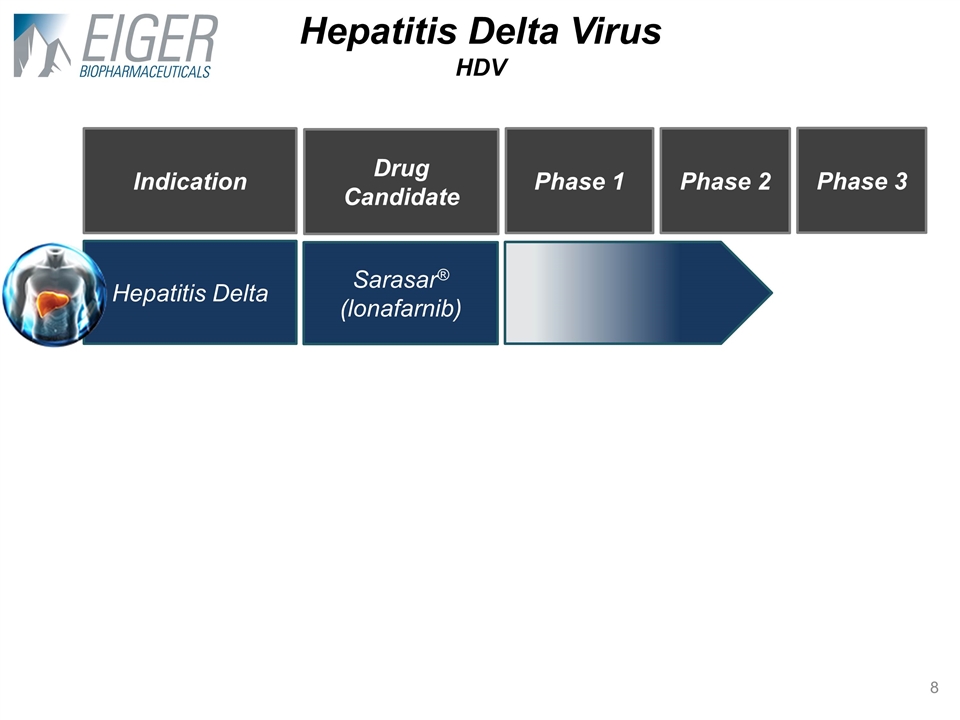
Hepatitis Delta Virus HDV Indication Drug
Candidate Phase 1 Phase 3 Phase 2 Hepatitis Delta Sarasar® (lonafarnib)
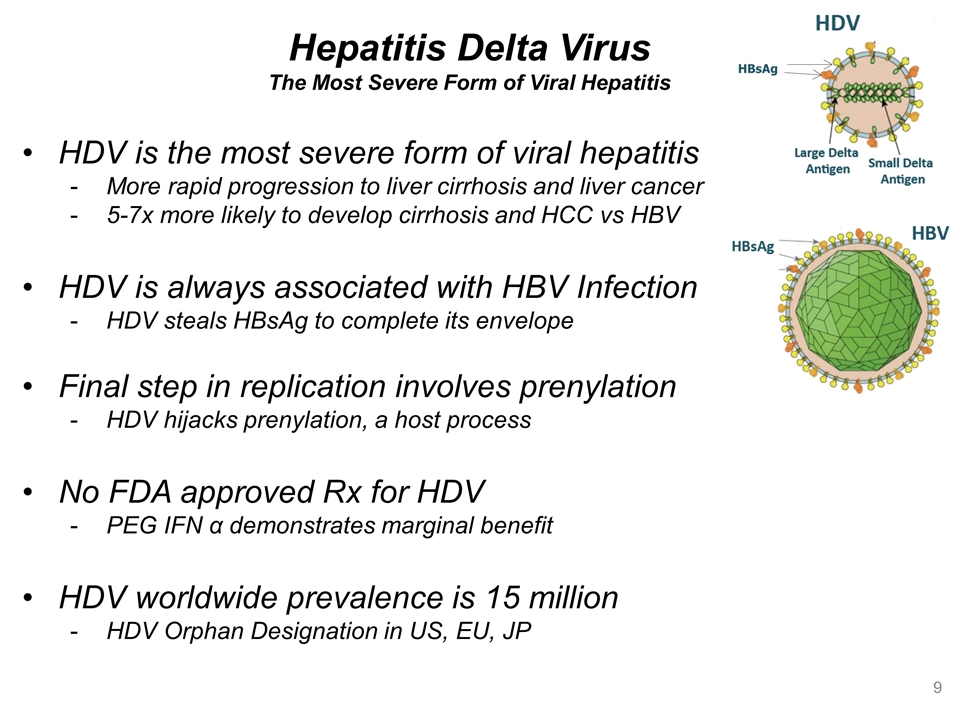
Hepatitis Delta Virus The Most Severe Form
of Viral Hepatitis HDV is the most severe form of viral hepatitis More rapid progression to liver cirrhosis and liver cancer 5-7x more likely to develop cirrhosis and HCC vs HBV HDV is always associated with HBV Infection HDV steals HBsAg to
complete its envelope Final step in replication involves prenylation HDV hijacks prenylation, a host process No FDA approved Rx for HDV PEG IFN α demonstrates marginal benefit HDV worldwide prevalence is 15 million HDV Orphan Designation in US,
EU, JP HBsAg
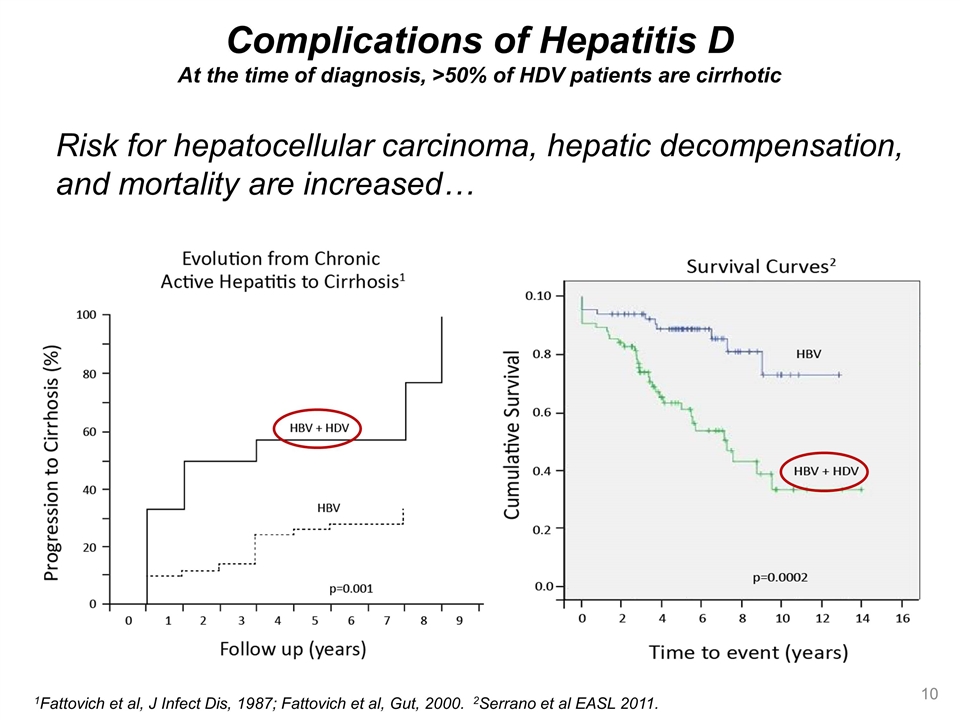
Complications of Hepatitis D At the time
of diagnosis, >50% of HDV patients are cirrhotic Risk for hepatocellular carcinoma, hepatic decompensation, and mortality are increased… 1Fattovich et al, J Infect Dis, 1987; Fattovich et al, Gut, 2000. 2Serrano et al EASL 2011.
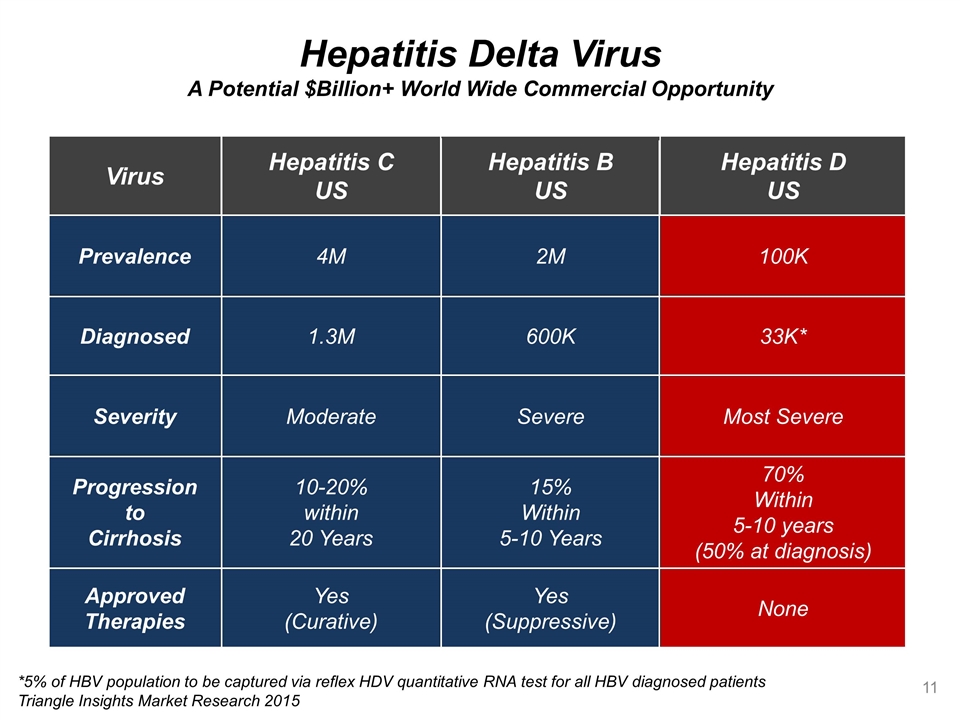
Hepatitis Delta Virus A Potential
$Billion+ World Wide Commercial Opportunity Virus Hepatitis C US Hepatitis B US Hepatitis D US Prevalence 4M 2M 100K Diagnosed 1.3M 600K 33K* Severity Moderate Severe Most Severe Progression to Cirrhosis 10-20% within 20 Years 15% Within 5-10 Years
70% Within 5-10 years (50% at diagnosis) Approved Therapies Yes (Curative) Yes (Suppressive) None *5% of HBV population to be captured via reflex HDV quantitative RNA test for all HBV diagnosed patients Triangle Insights Market Research 2015
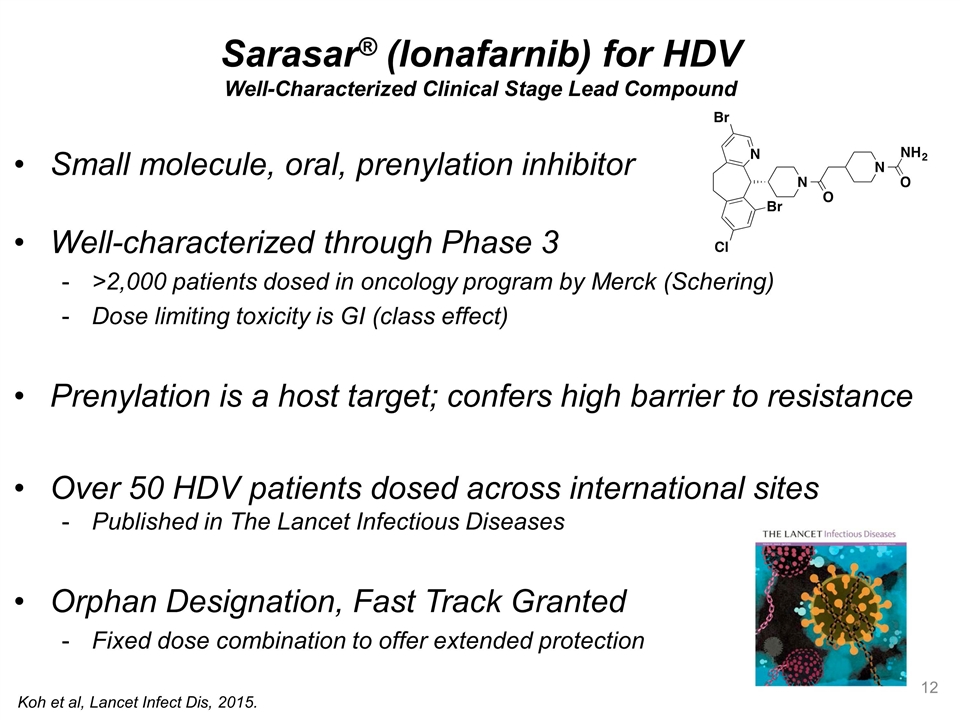
Sarasar® (lonafarnib) for HDV
Well-Characterized Clinical Stage Lead Compound Small molecule, oral, prenylation inhibitor Well-characterized through Phase 3 >2,000 patients dosed in oncology program by Merck (Schering) Dose limiting toxicity is GI (class effect) Prenylation
is a host target; confers high barrier to resistance Over 50 HDV patients dosed across international sites Published in The Lancet Infectious Diseases Orphan Designation, Fast Track Granted Fixed dose combination to offer extended protection Koh et
al, Lancet Infect Dis, 2015.
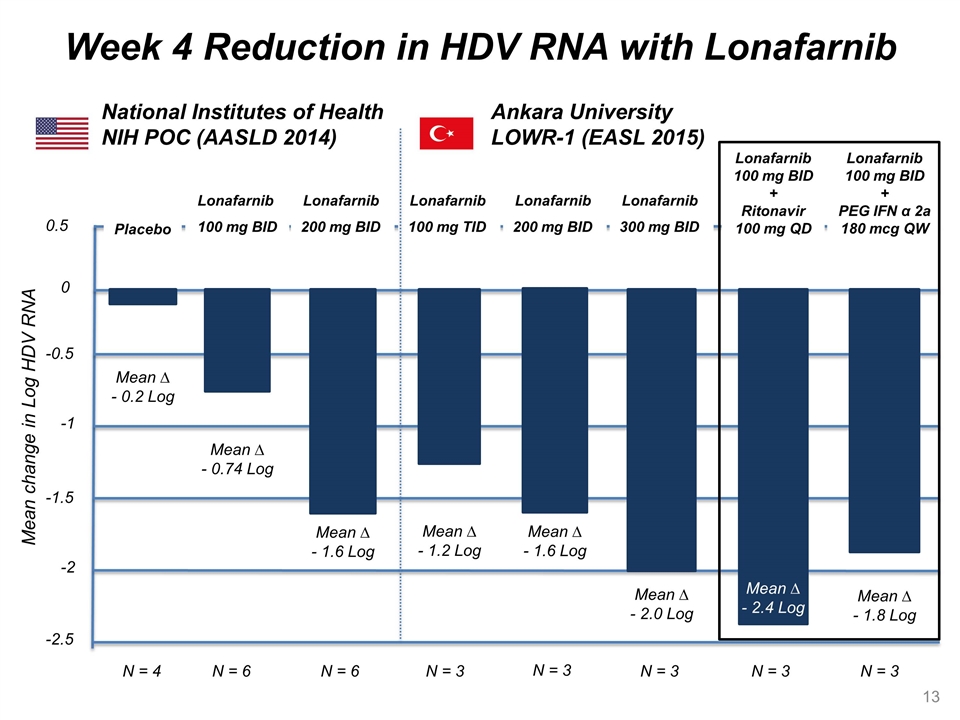
Week 4 Reduction in HDV RNA with
Lonafarnib Lonafarnib 100 mg BID Placebo Lonafarnib 100 mg BID + Ritonavir 100 mg QD 0.5 0 -0.5 -1 -1.5 -2 -2.5 Mean ∆ - 0.74 Log Mean ∆ - 2.4 Log Mean ∆ - 0.2 Log N = 4 N = 6 N = 3 Mean change in Log HDV RNA Mean ∆ - 1.8 Log
Lonafarnib 100 mg BID + PEG IFN α 2a 180 mcg QW N = 3 Lonafarnib 200 mg BID Mean ∆ - 1.6 Log N = 6 N = 3 Lonafarnib 300 mg BID Mean ∆ - 2.0 Log Lonafarnib 200 mg BID Mean ∆ - 1.6 Log N = 3 National Institutes of Health NIH POC
(AASLD 2014) N = 3 Lonafarnib 100 mg TID Mean ∆ - 1.2 Log Ankara University LOWR-1 (EASL 2015)
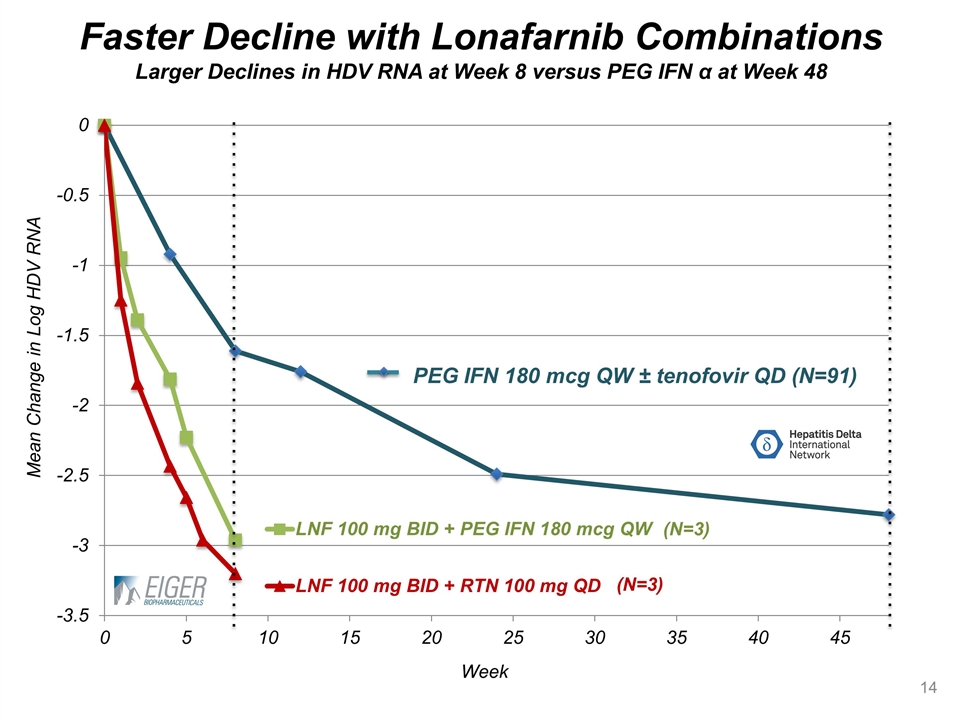
Faster Decline with Lonafarnib
Combinations Larger Declines in HDV RNA at Week 8 versus PEG IFN α at Week 48 Mean Change in Log HDV RNA Week (N=3) (N=3)
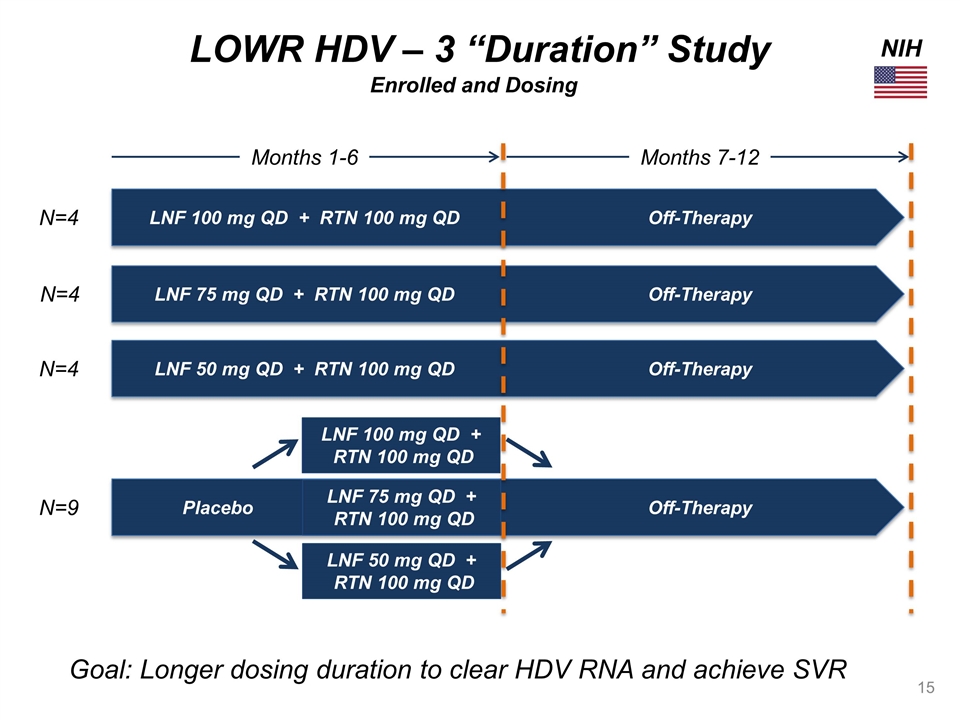
N=4 N=4 LNF 50 mg QD + RTN 100 mg QD
LOWR HDV – 3 “Duration” Study Enrolled and Dosing Months 7-12 Off-Therapy Months 1-6 N=9 Placebo Off-Therapy N=4 LNF 75 mg QD + RTN 100 mg QD Off-Therapy LNF 100 mg QD + RTN 100 mg QD LNF 75 mg QD + RTN 100 mg QD LNF 50 mg QD + RTN
100 mg QD LNF 100 mg QD + RTN 100 mg QD Off-Therapy Goal: Longer dosing duration to clear HDV RNA and achieve SVR NIH
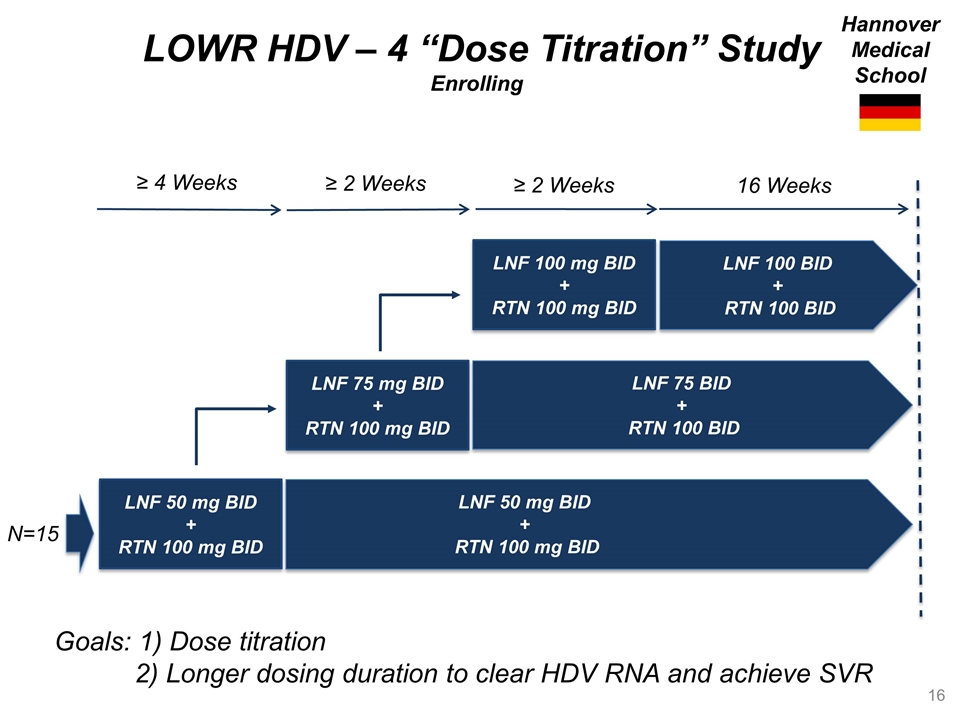
LNF 50 mg BID + RTN 100 mg BID ≥ 4
Weeks N=15 ≥ 2 Weeks ≥ 2 Weeks 16 Weeks LOWR HDV – 4 “Dose Titration” Study Enrolling 16 LNF 50 mg BID + RTN 100 mg BID LNF 75 BID + RTN 100 BID LNF 75 mg BID + RTN 100 mg BID LNF 100 BID + RTN 100 BID LNF 100 mg BID +
RTN 100 mg BID Goals: 1) Dose titration 2) Longer dosing duration to clear HDV RNA and achieve SVR Hannover Medical School
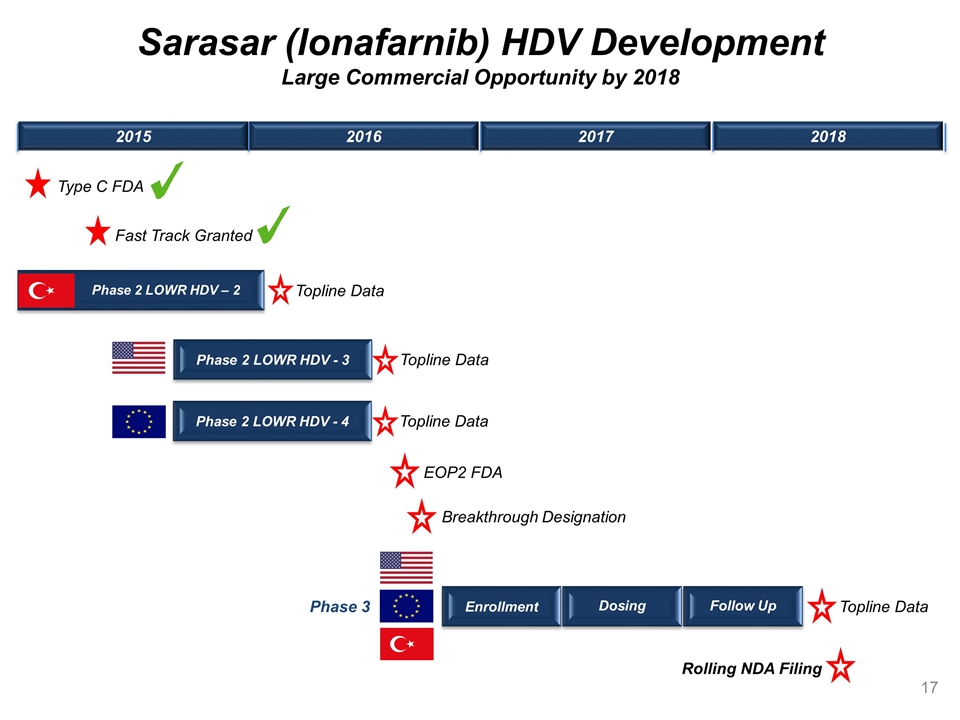
Fast Track Granted EOP2 FDA Phase 2 LOWR
HDV – 2 Enrollment Phase 2 LOWR HDV - 3 Rolling NDA Filing Phase 3 Follow Up Topline Data 2015 2016 2017 2018 Sarasar (lonafarnib) HDV Development Large Commercial Opportunity by 2018 Breakthrough Designation Type C FDA Topline Data Dosing
Topline Data Phase 2 LOWR HDV - 4 Topline Data
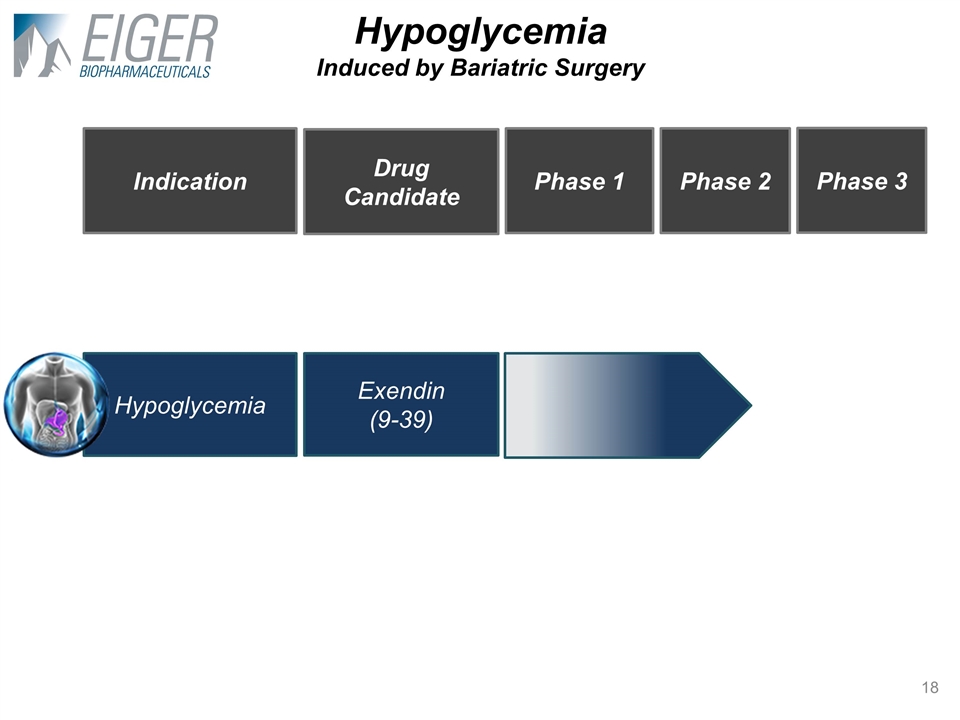
Hypoglycemia Induced by Bariatric
Surgery Indication Drug Candidate Phase 1 Phase 3 Phase 2 Hypoglycemia Exendin (9-39)
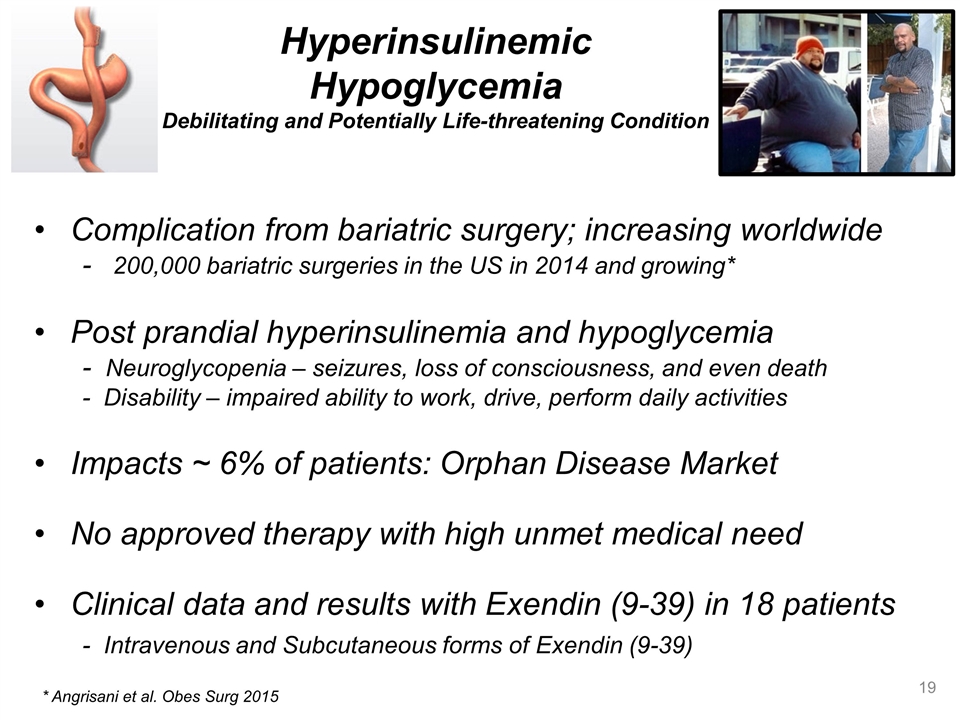
Hyperinsulinemic Hypoglycemia
Debilitating and Potentially Life-threatening Condition Complication from bariatric surgery; increasing worldwide - 200,000 bariatric surgeries in the US in 2014 and growing* Post prandial hyperinsulinemia and hypoglycemia - Neuroglycopenia –
seizures, loss of consciousness, and even death - Disability – impaired ability to work, drive, perform daily activities Impacts ~ 6% of patients: Orphan Disease Market No approved therapy with high unmet medical need Clinical data and results
with Exendin (9-39) in 18 patients - Intravenous and Subcutaneous forms of Exendin (9-39) * Angrisani et al. Obes Surg 2015
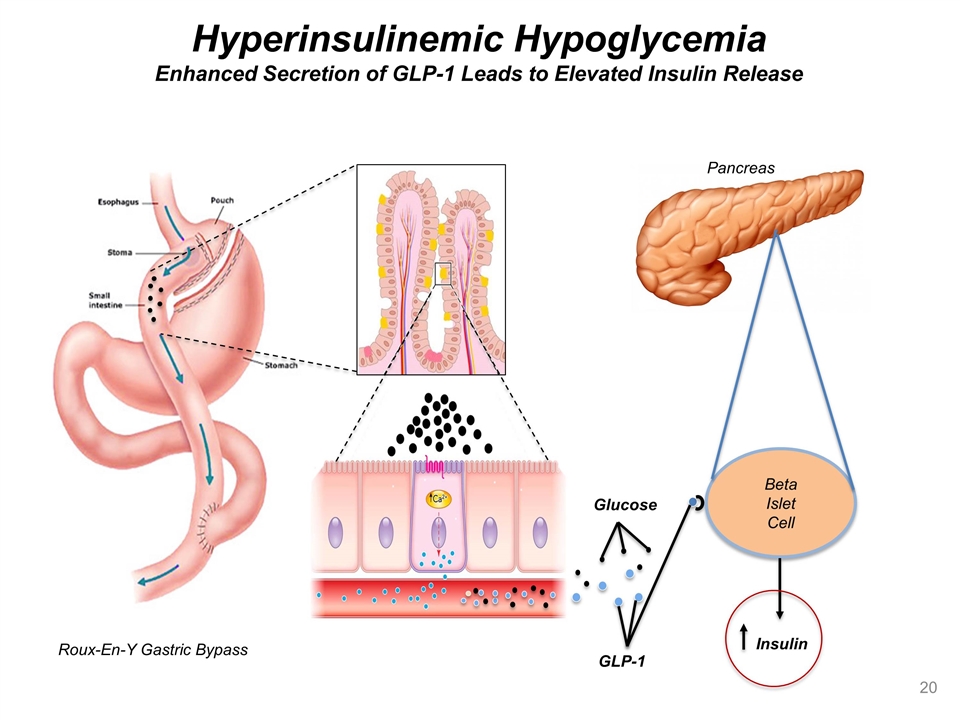
Hyperinsulinemic Hypoglycemia Enhanced
Secretion of GLP-1 Leads to Elevated Insulin Release Roux-En-Y Gastric Bypass 20 Glucose GLP-1 Insulin Beta Islet Cell Pancreas
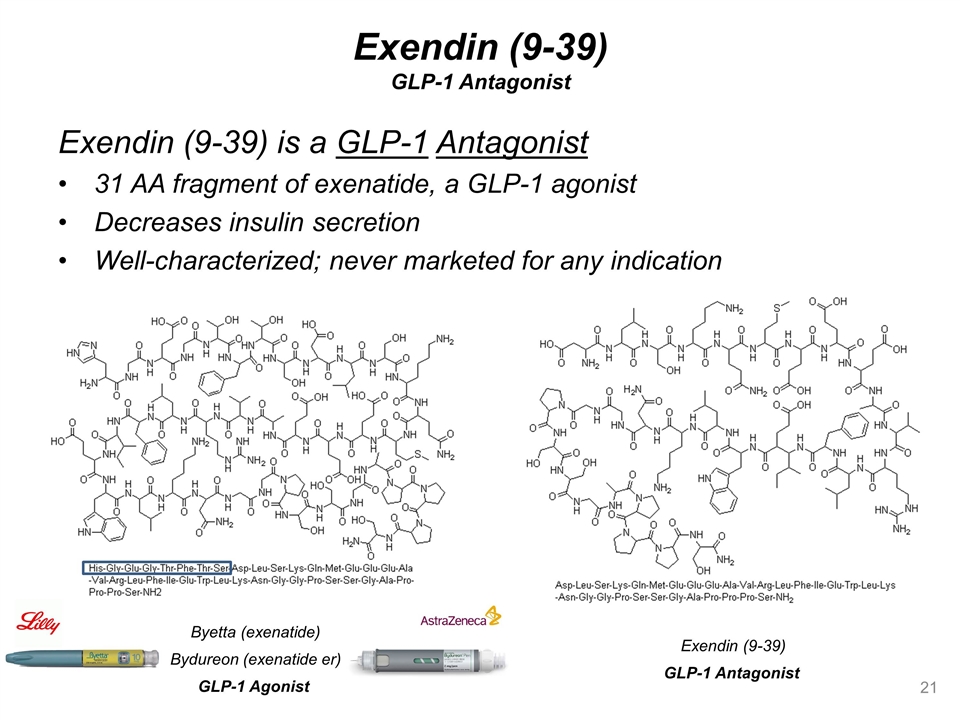
Exendin (9-39) GLP-1 Antagonist Exendin
(9-39) is a GLP-1 Antagonist 31 AA fragment of exenatide, a GLP-1 agonist Decreases insulin secretion Well-characterized; never marketed for any indication Byetta (exenatide) Bydureon (exenatide er) GLP-1 Agonist Exendin (9-39) GLP-1 Antagonist
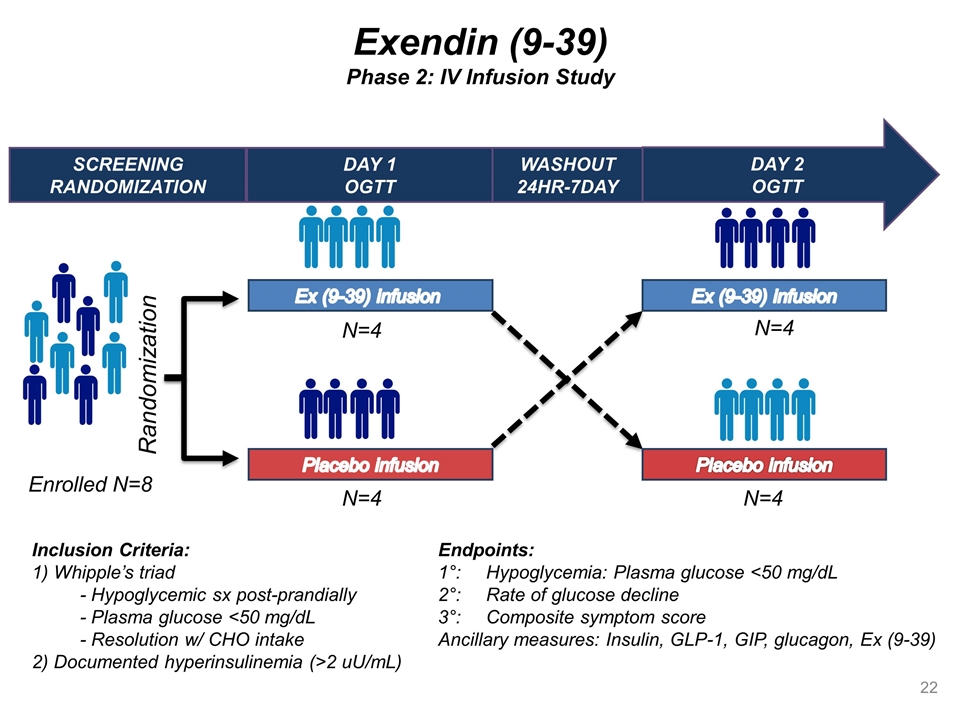
Exendin (9-39) Phase 2: IV Infusion
Study Randomization Ex (9-39) infusion Placebo infusion Ex (9-39) infusion Placebo infusion N=4 N=4 DAY 1 OGTT DAY 2 OGTT SCREENING RANDOMIZATION WASHOUT 24HR-7DAY Enrolled N=8 Inclusion Criteria: 1) Whipple’s triad - Hypoglycemic sx
post-prandially - Plasma glucose <50 mg/dL - Resolution w/ CHO intake 2) Documented hyperinsulinemia (>2 uU/mL) N=4 N=4 Endpoints: 1°: Hypoglycemia: Plasma glucose <50 mg/dL 2°: Rate of glucose decline 3°: Composite symptom
score Ancillary measures: Insulin, GLP-1, GIP, glucagon, Ex (9-39) 22
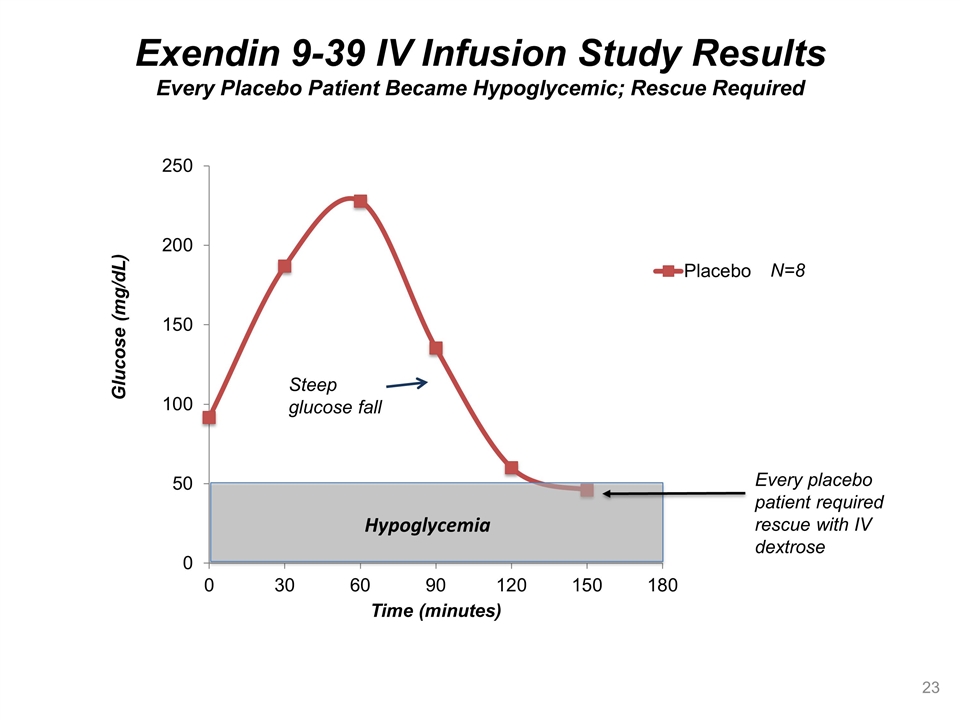
Exendin 9-39 IV Infusion Study Results
Every Placebo Patient Became Hypoglycemic; Rescue Required Hypoglycemia N=8 Every placebo patient required rescue with IV dextrose
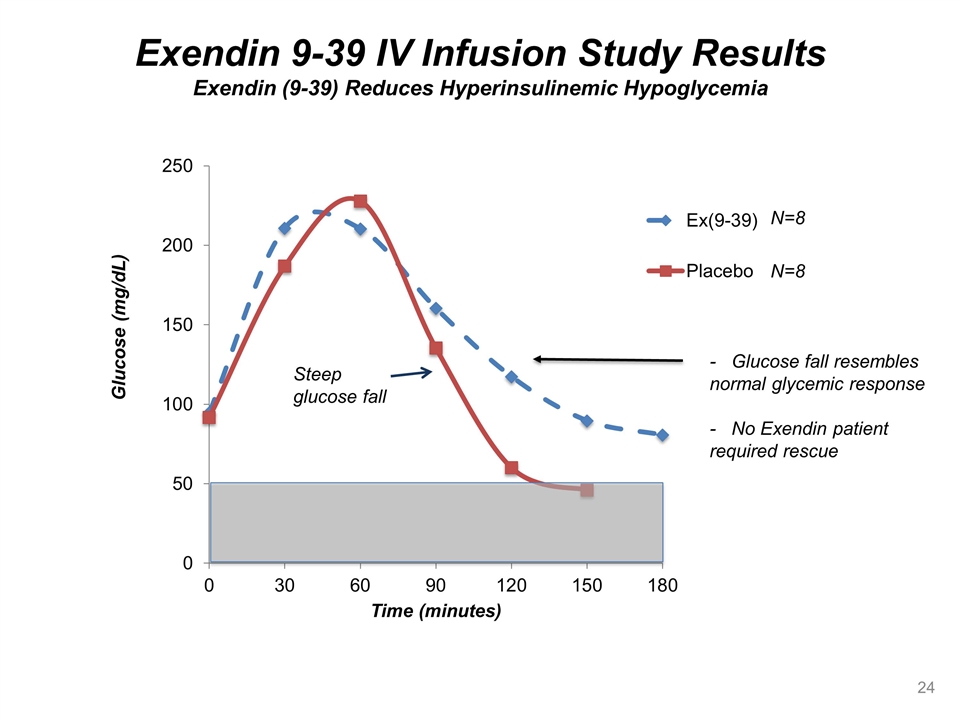
Exendin 9-39 IV Infusion Study Results
Exendin (9-39) Reduces Hyperinsulinemic Hypoglycemia Steep glucose fall - Glucose fall resembles normal glycemic response - No Exendin patient required rescue
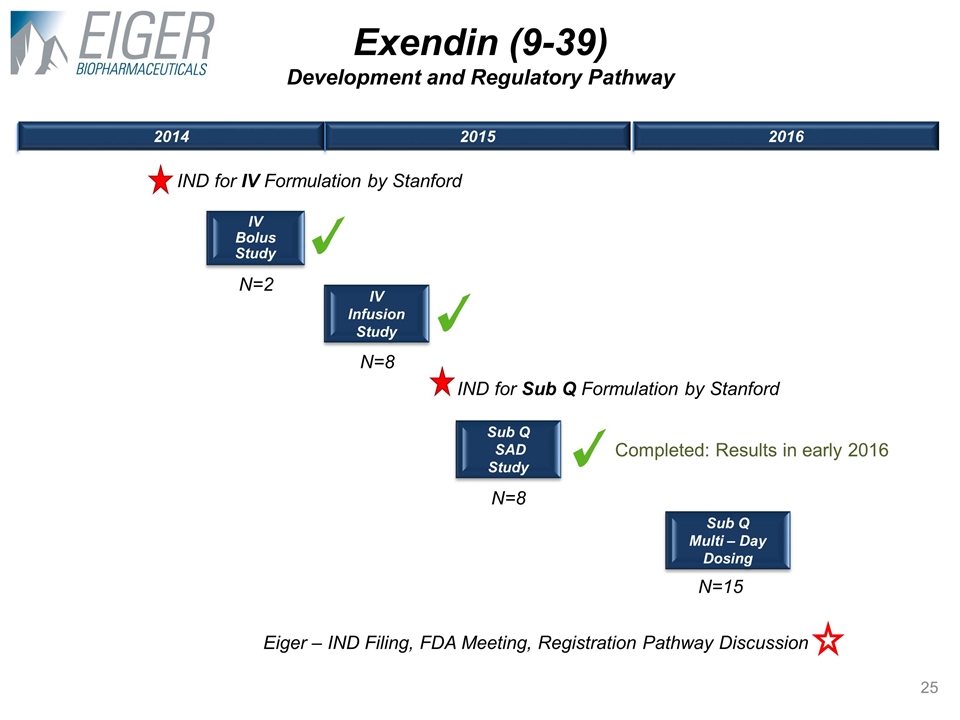
IV Bolus Study IV Infusion Study 2014
2015 2016 Exendin (9-39) Development and Regulatory Pathway IND for IV Formulation by Stanford N=8 N=2 Sub Q Multi – Day Dosing N=15 Eiger – IND Filing, FDA Meeting, Registration Pathway Discussion IND for Sub Q Formulation by Stanford
Sub Q SAD Study N=8 Completed: Results in early 2016
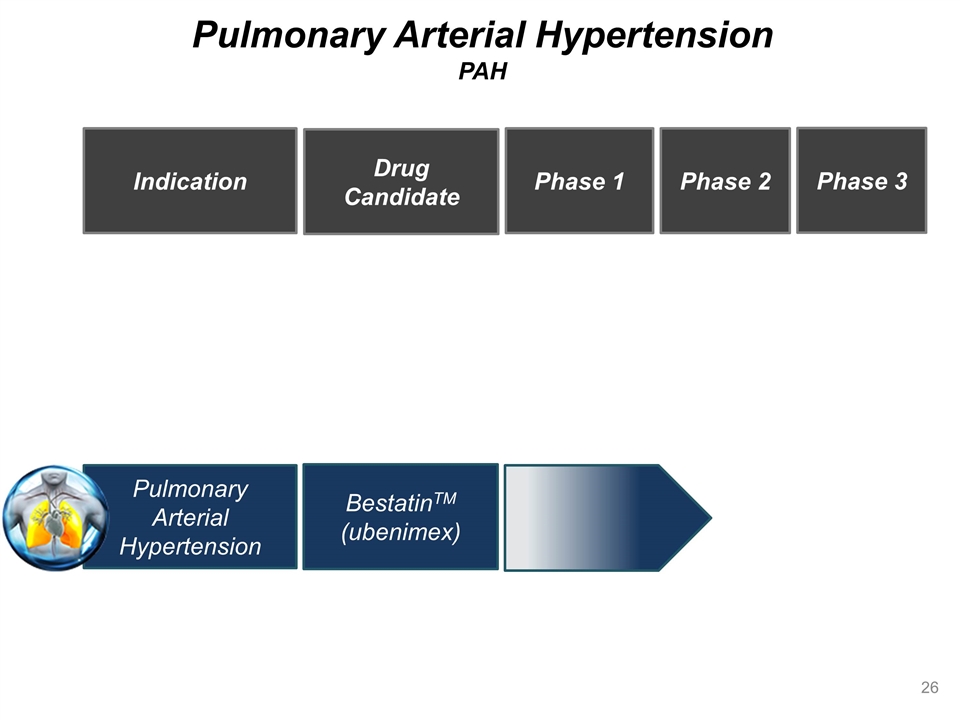
Pulmonary Arterial Hypertension PAH
Indication Drug Candidate Phase 1 Phase 3 Phase 2 Pulmonary Arterial Hypertension BestatinTM (ubenimex)
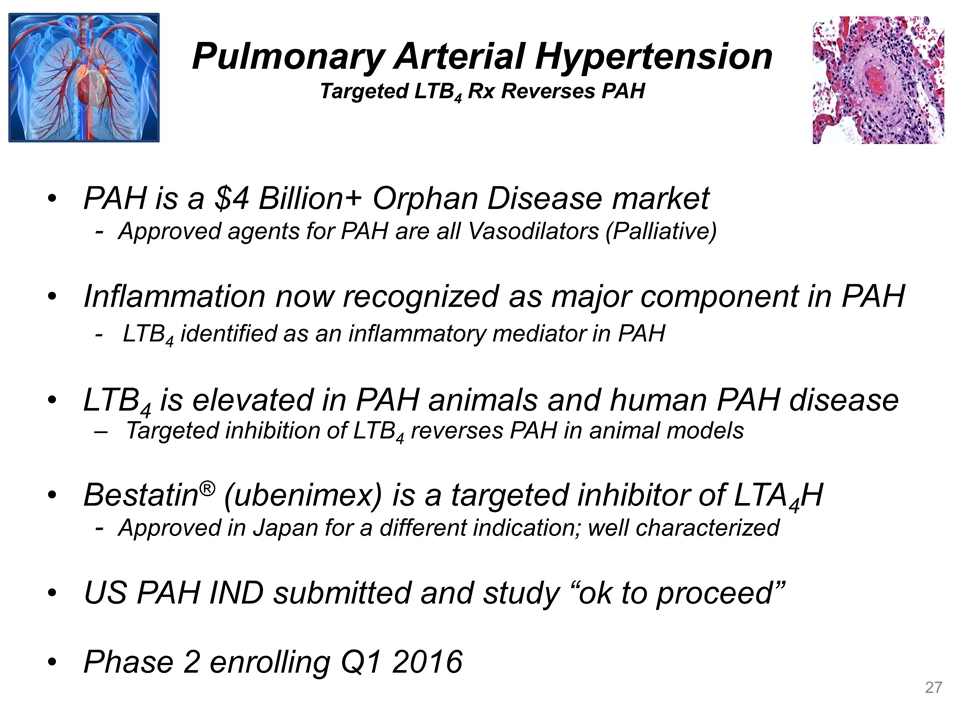
Pulmonary Arterial Hypertension Targeted
LTB4 Rx Reverses PAH PAH is a $4 Billion+ Orphan Disease market - Approved agents for PAH are all Vasodilators (Palliative) Inflammation now recognized as major component in PAH - LTB4 identified as an inflammatory mediator in PAH LTB4 is elevated
in PAH animals and human PAH disease Targeted inhibition of LTB4 reverses PAH in animal models Bestatin® (ubenimex) is a targeted inhibitor of LTA4H - Approved in Japan for a different indication; well characterized US PAH IND submitted and
study “ok to proceed” Phase 2 enrolling Q1 2016
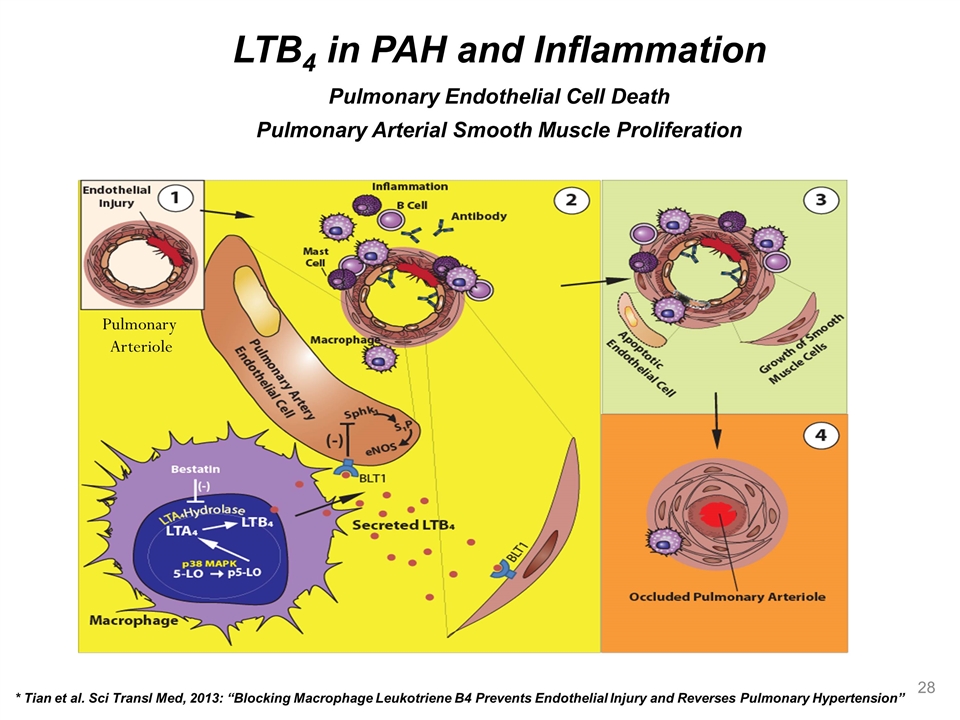
LTB4 in PAH and Inflammation * Tian et
al. Sci Transl Med, 2013: “Blocking Macrophage Leukotriene B4 Prevents Endothelial Injury and Reverses Pulmonary Hypertension” * Pulmonary Arteriole Pulmonary Endothelial Cell Death Pulmonary Arterial Smooth Muscle
Proliferation
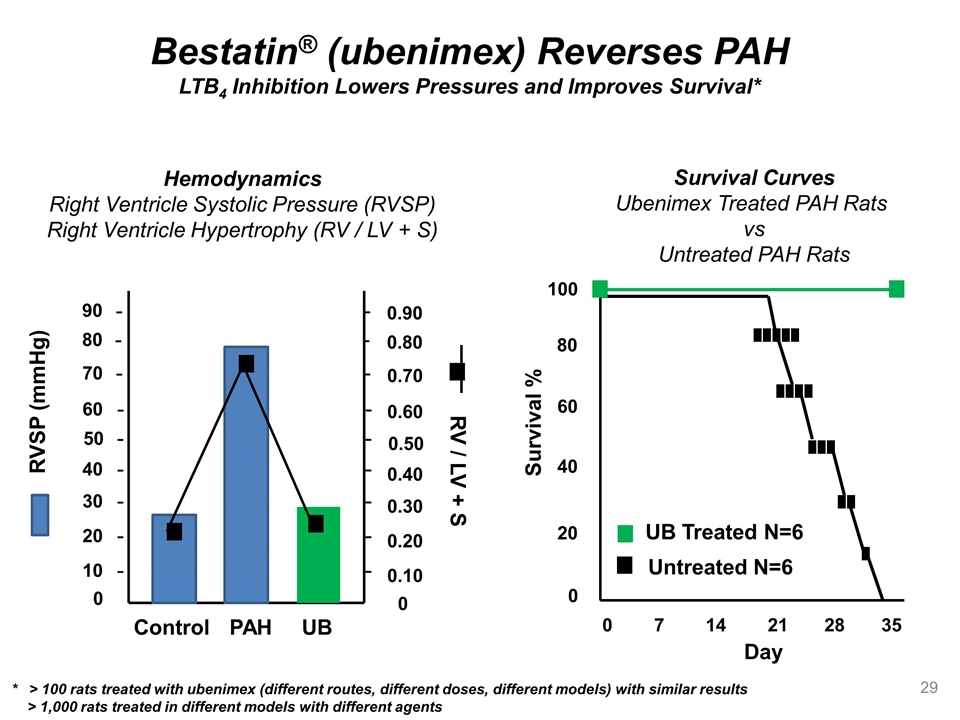
- - - - - 10 0 20 30 40 50 60 Control
PAH RVSP (mmHg) RV / LV + S UB - - - - 70 90 80 - - - - - 0.10 0 0.20 0.30 0.40 0.50 0.60 - - - - 0.70 0.90 0.80 Hemodynamics Right Ventricle Systolic Pressure (RVSP) Right Ventricle Hypertrophy (RV / LV + S) Survival Curves Ubenimex Treated PAH
Rats vs Untreated PAH Rats 0 20 40 60 100 80 Survival % Day 0 7 14 21 28 35 UB Treated N=6 Untreated N=6 * > 100 rats treated with ubenimex (different routes, different doses, different models) with similar results > 1,000 rats treated in
different models with different agents Bestatin® (ubenimex) Reverses PAH LTB4 Inhibition Lowers Pressures and Improves Survival*
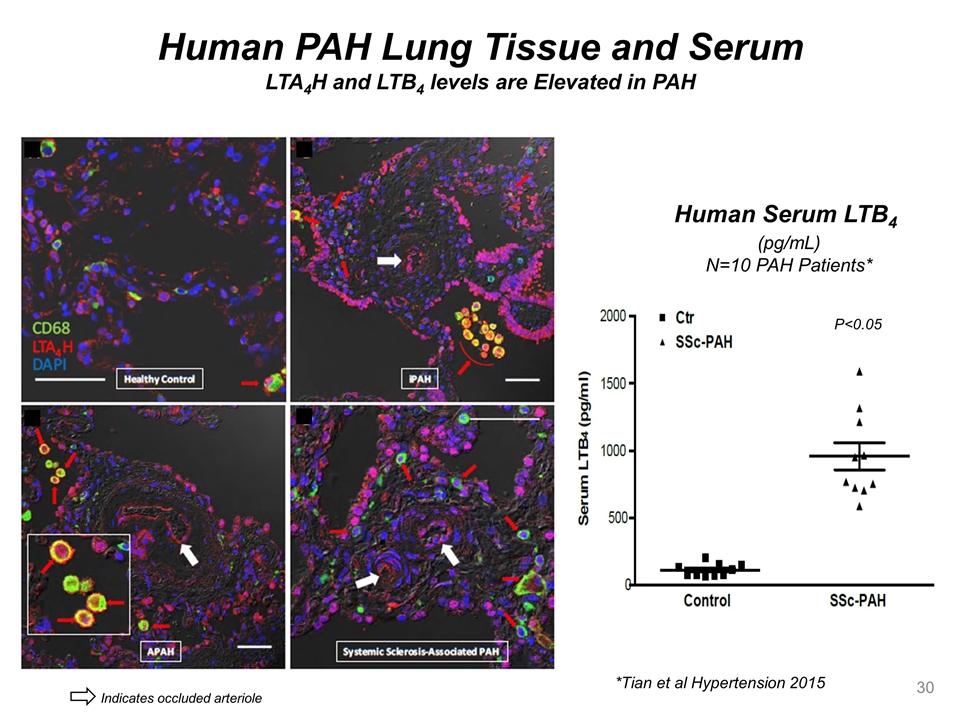
Human PAH Lung Tissue and Serum LTA4H
and LTB4 levels are Elevated in PAH Indicates occluded arteriole Human Serum LTB4 (pg/mL) N=10 PAH Patients* *Tian et al Hypertension 2015 P<0.05
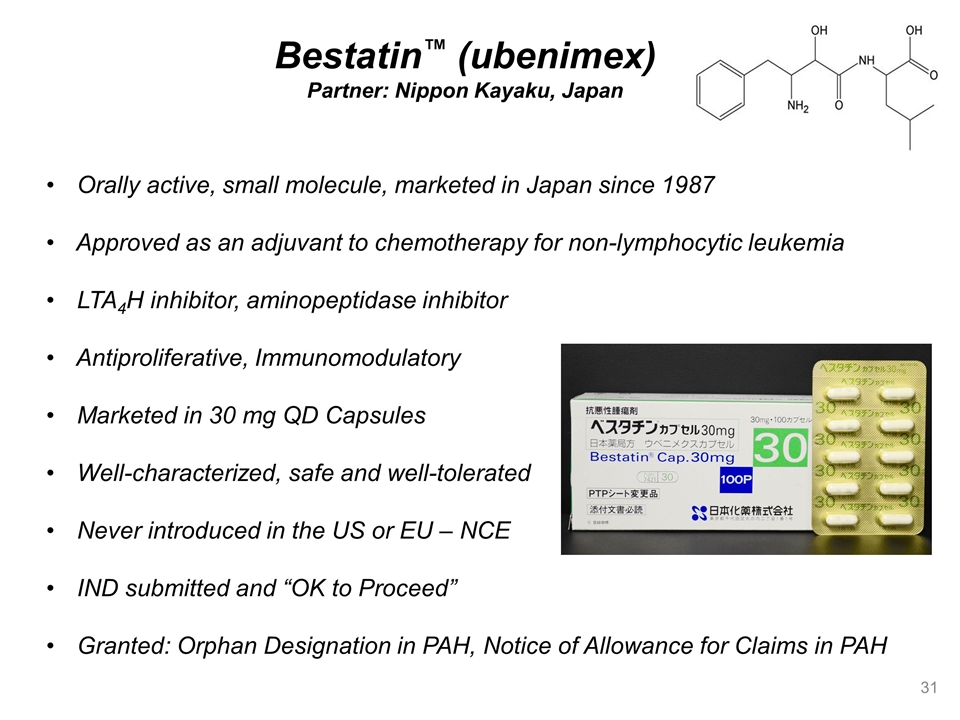
Bestatin™ (ubenimex) Partner:
Nippon Kayaku, Japan Orally active, small molecule, marketed in Japan since 1987 Approved as an adjuvant to chemotherapy for non-lymphocytic leukemia LTA4H inhibitor, aminopeptidase inhibitor Antiproliferative, Immunomodulatory Marketed in 30 mg QD
Capsules Well-characterized, safe and well-tolerated Never introduced in the US or EU – NCE IND submitted and “OK to Proceed” Granted: Orphan Designation in PAH, Notice of Allowance for Claims in PAH
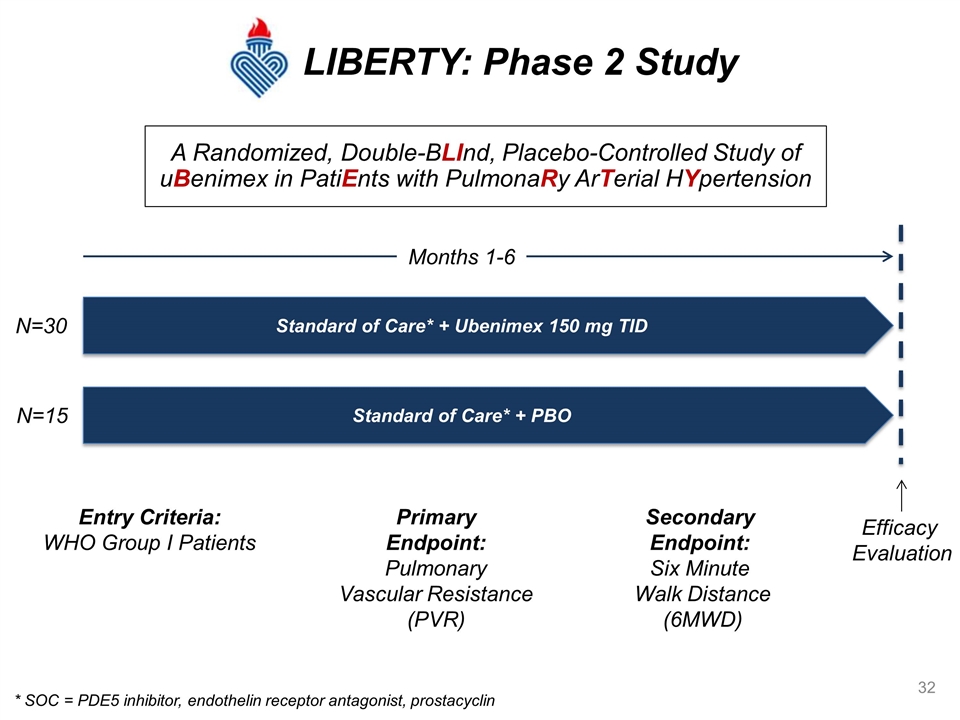
N=30 LIBERTY: Phase 2 Study Months 1-6
N=15 Standard of Care* + Ubenimex 150 mg TID Standard of Care* + PBO * SOC = PDE5 inhibitor, endothelin receptor antagonist, prostacyclin Primary Endpoint: Pulmonary Vascular Resistance (PVR) Secondary Endpoint: Six Minute Walk Distance (6MWD) A
Randomized, Double-BLInd, Placebo-Controlled Study of uBenimex in PatiEnts with PulmonaRy ArTerial HYpertension Efficacy Evaluation Entry Criteria: WHO Group I Patients
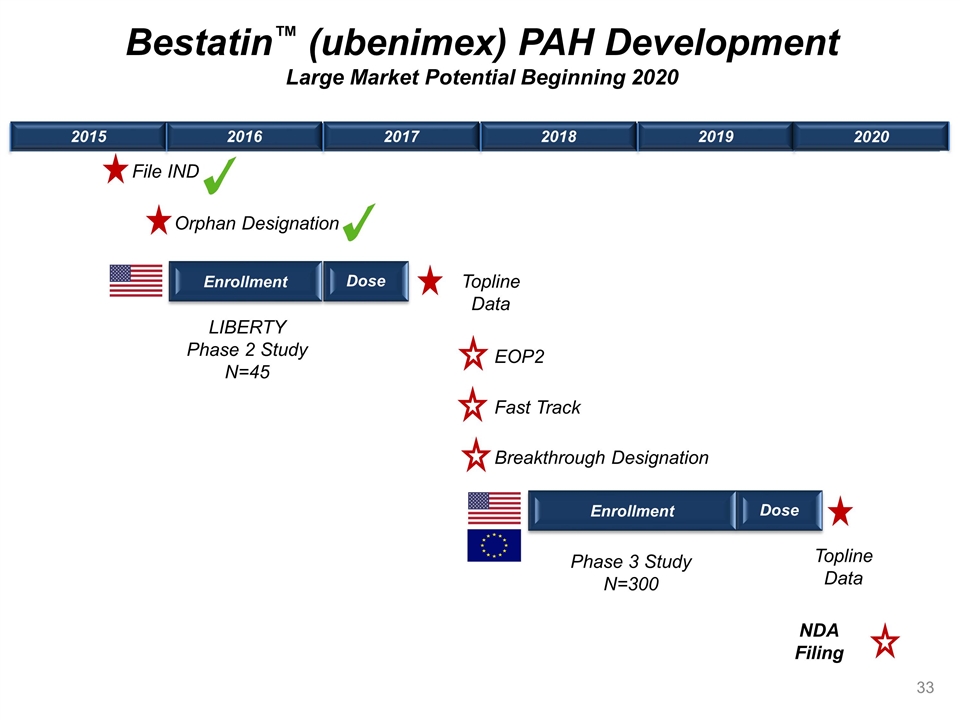
LIBERTY Phase 2 Study N=45 Fast Track
Orphan Designation EOP2 File IND Dose Enrollment Enrollment NDA Filing Phase 3 Study N=300 Dose Topline Data Topline Data 2019 2015 2016 2017 2018 2020 Bestatin™ (ubenimex) PAH Development Large Market Potential Beginning 2020 Breakthrough
Designation
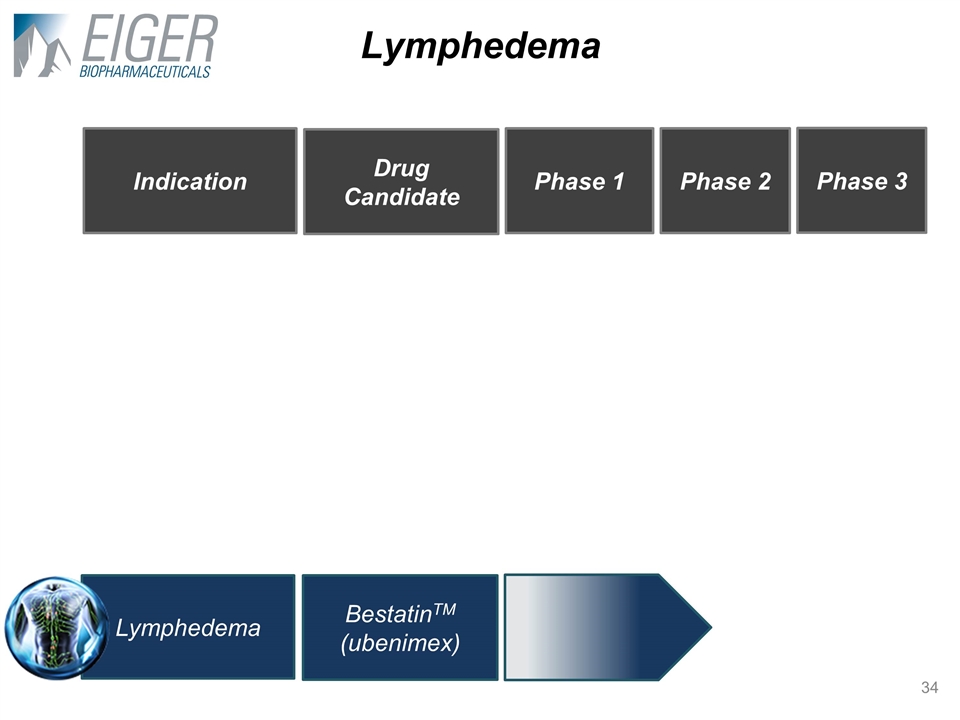
Lymphedema Indication Drug Candidate
Phase 1 Phase 3 Phase 2 Lymphedema BestatinTM (ubenimex)
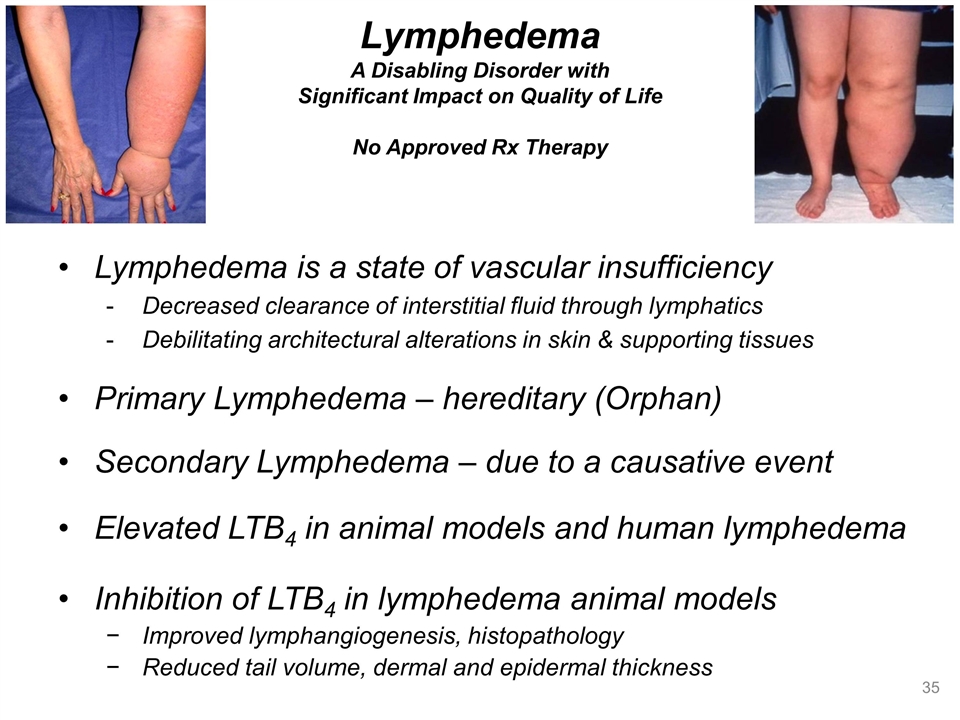
Lymphedema A Disabling Disorder with
Significant Impact on Quality of Life No Approved Rx Therapy Lymphedema is a state of vascular insufficiency Decreased clearance of interstitial fluid through lymphatics Debilitating architectural alterations in skin & supporting tissues Primary
Lymphedema – hereditary (Orphan) Secondary Lymphedema – due to a causative event Elevated LTB4 in animal models and human lymphedema Inhibition of LTB4 in lymphedema animal models Improved lymphangiogenesis, histopathology Reduced tail
volume, dermal and epidermal thickness
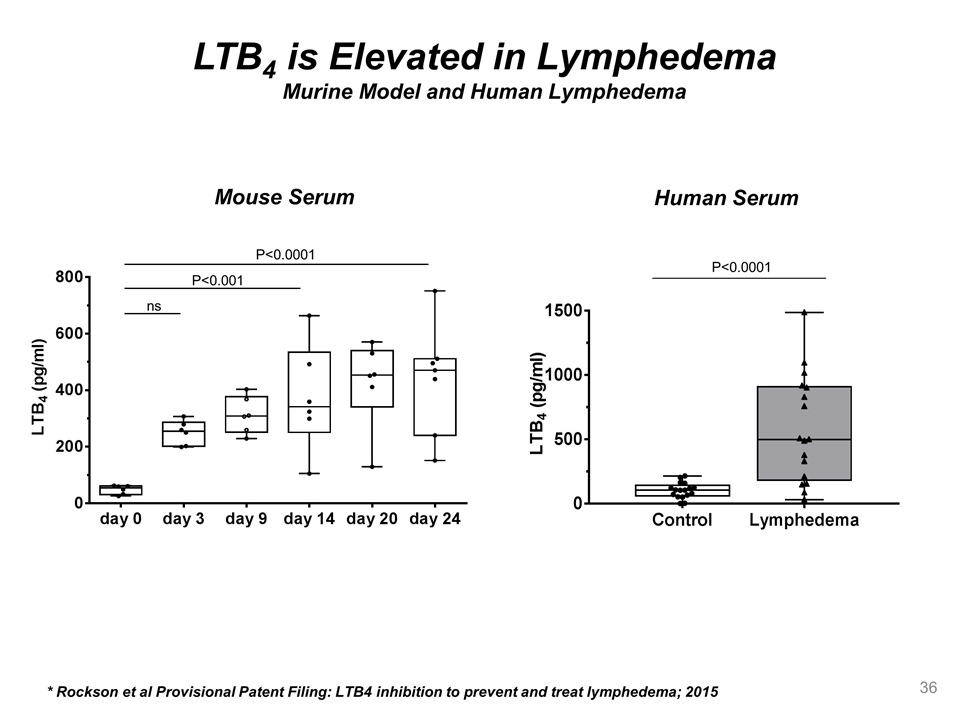
LTB4 is Elevated in Lymphedema Murine
Model and Human Lymphedema Human Serum P<0.0001 P<0.0001 P<0.001 ns Mouse Serum * Rockson et al Provisional Patent Filing: LTB4 inhibition to prevent and treat lymphedema; 2015
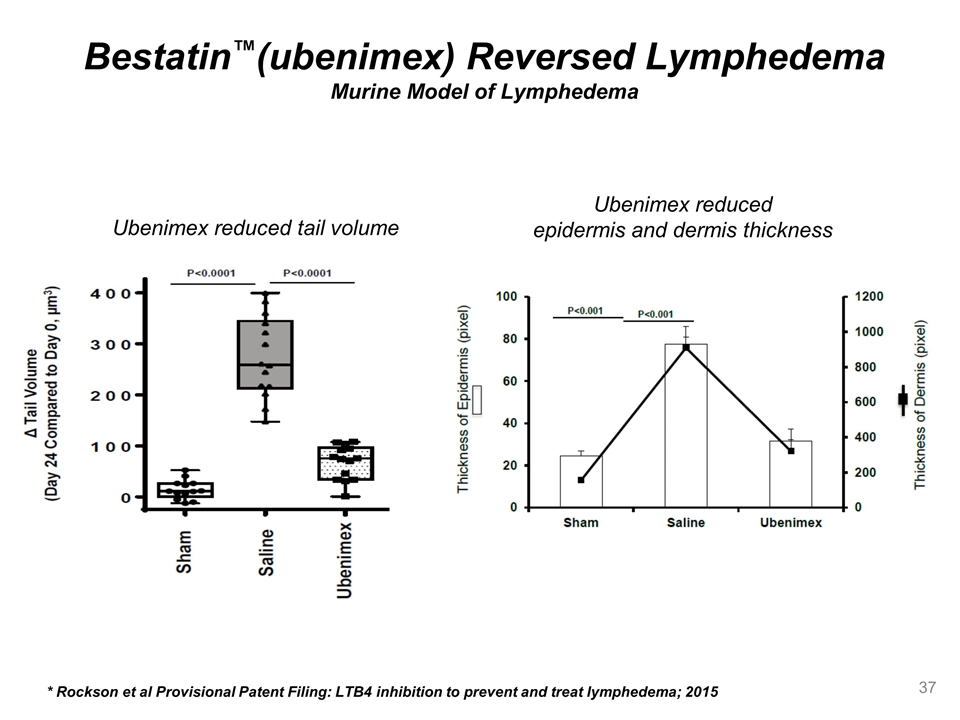
Bestatin™(ubenimex) Reversed
Lymphedema Murine Model of Lymphedema Ubenimex reduced epidermis and dermis thickness * Rockson et al Provisional Patent Filing: LTB4 inhibition to prevent and treat lymphedema; 2015 Ubenimex reduced tail volume
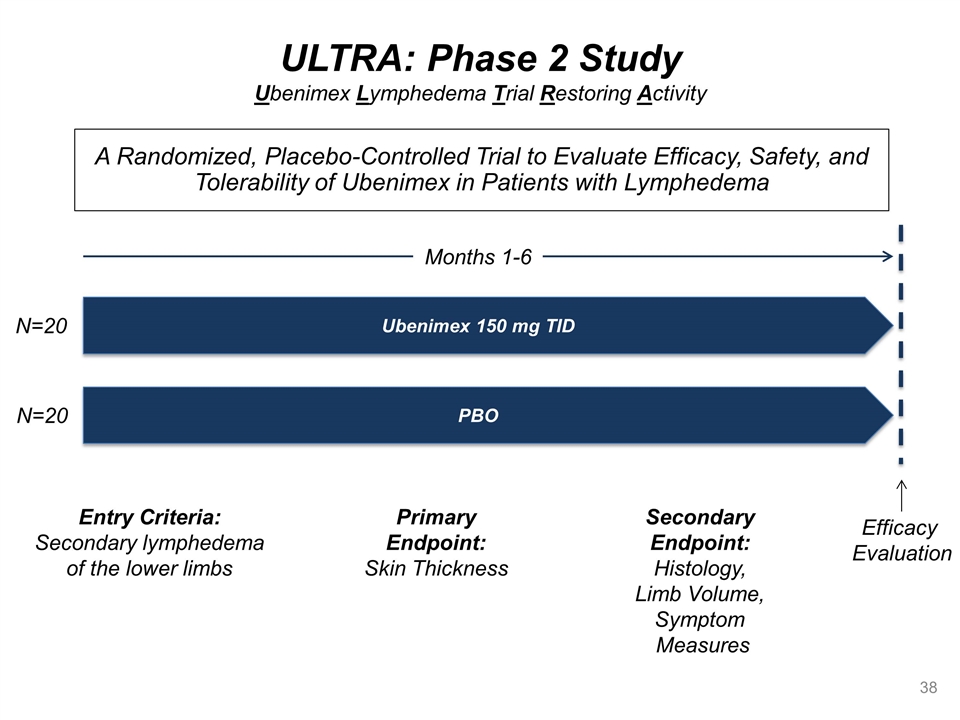
N=20 Months 1-6 N=20 Ubenimex 150 mg TID
PBO Primary Endpoint: Skin Thickness Secondary Endpoint: Histology, Limb Volume, Symptom Measures Efficacy Evaluation Entry Criteria: Secondary lymphedema of the lower limbs ULTRA: Phase 2 Study Ubenimex Lymphedema Trial Restoring Activity A
Randomized, Placebo-Controlled Trial to Evaluate Efficacy, Safety, and Tolerability of Ubenimex in Patients with Lymphedema
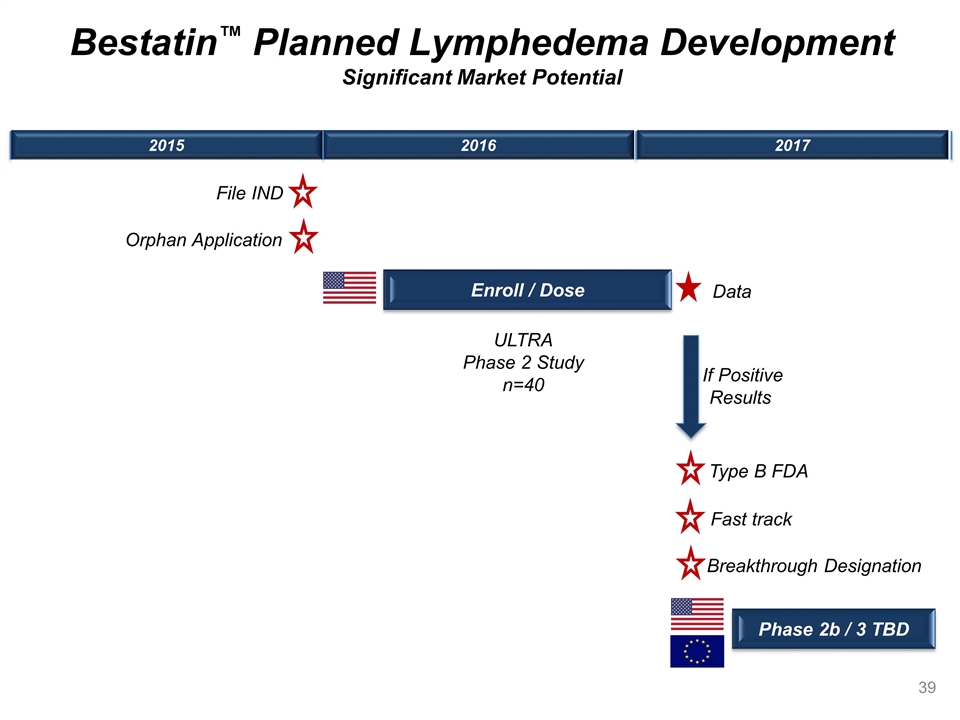
ULTRA Phase 2 Study n=40 Fast track
Orphan Application Type B FDA File IND Enroll / Dose Data 2015 2016 2017 Breakthrough Designation If Positive Results Phase 2b / 3 TBD Bestatin™ Planned Lymphedema Development Significant Market Potential
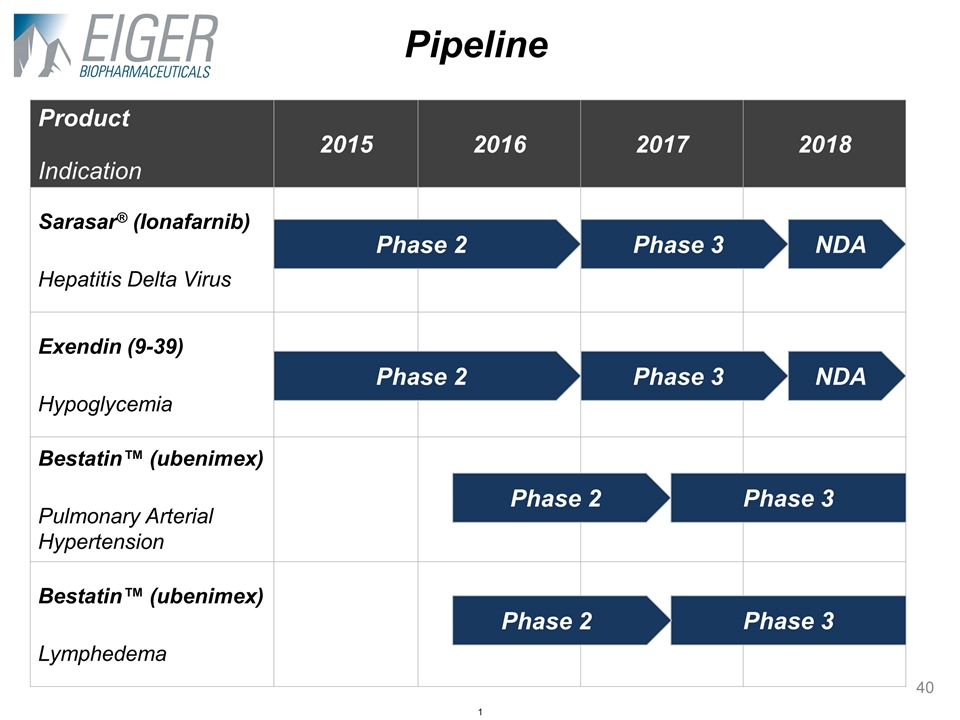
Pipeline Product Indication 2015 2016
2017 2018 Sarasar® (Ionafarnib) Hepatitis Delta Virus Exendin (9-39) Hypoglycemia Bestatin™ (ubenimex) Pulmonary Arterial Hypertension Bestatin™ (ubenimex) Lymphedema Phase 2 Phase 3 NDA Phase 2 Phase 3 NDA Phase 2 Phase 3 Phase 3 1
40 Phase 2
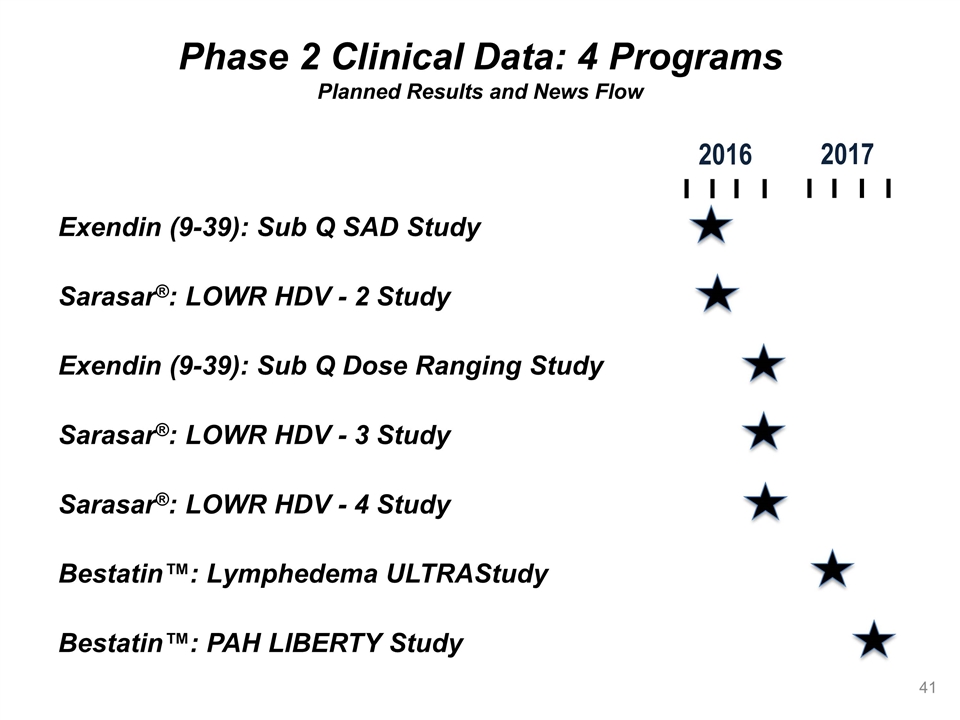
Phase 2 Clinical Data: 4 Programs
Planned Results and News Flow 2016 Exendin (9-39): Sub Q SAD Study Sarasar®: LOWR HDV - 2 Study Exendin (9-39): Sub Q Dose Ranging Study Sarasar®: LOWR HDV - 3 Study Sarasar®: LOWR HDV - 4 Study Bestatin™: Lymphedema ULTRAStudy
Bestatin™: PAH LIBERTY Study 2017
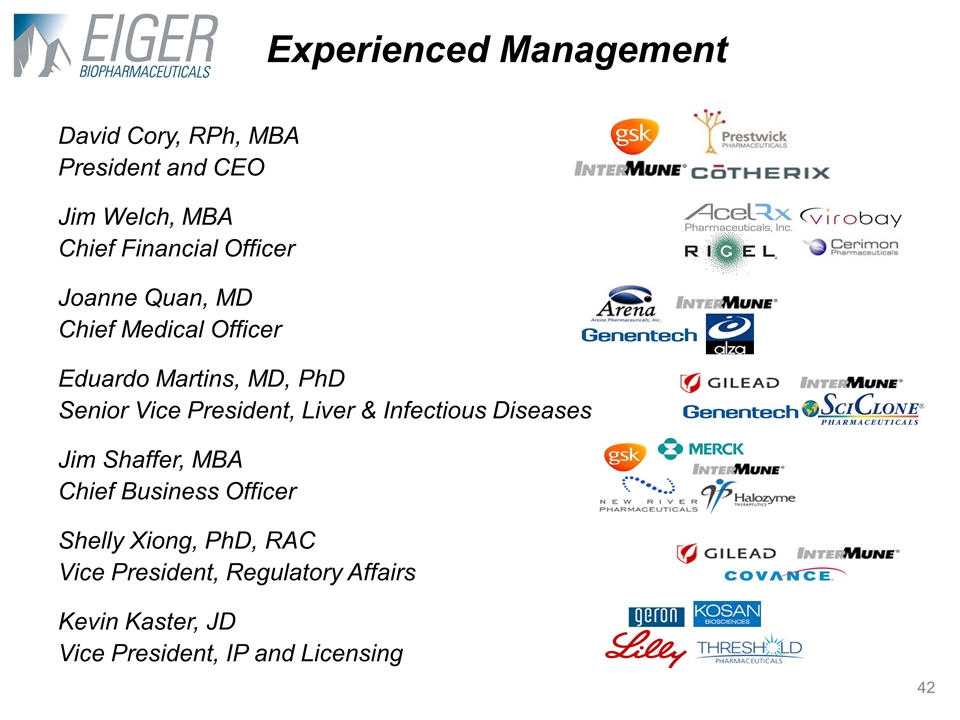
Experienced Management David Cory, RPh,
MBA President and CEO Jim Welch, MBA Chief Financial Officer Joanne Quan, MD Chief Medical Officer Eduardo Martins, MD, PhD Senior Vice President, Liver & Infectious Diseases Jim Shaffer, MBA Chief Business Officer Shelly Xiong, PhD, RAC Vice
President, Regulatory Affairs Kevin Kaster, JD Vice President, IP and Licensing
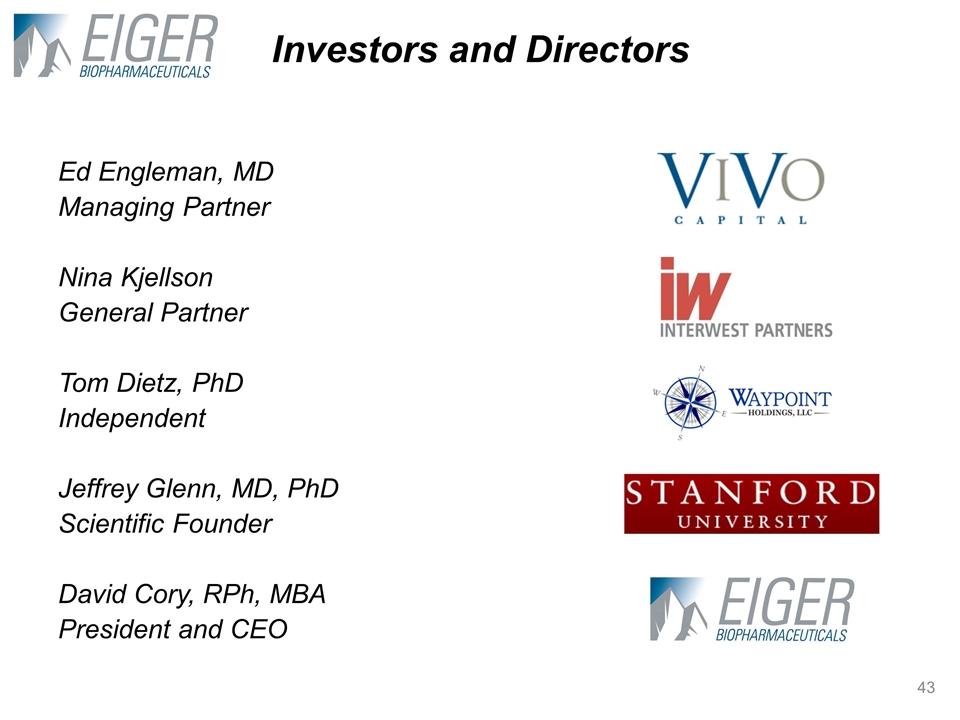
Investors and Directors Ed Engleman, MD
Managing Partner Nina Kjellson General Partner Tom Dietz, PhD Independent Jeffrey Glenn, MD, PhD Scientific Founder David Cory, RPh, MBA President and CEO
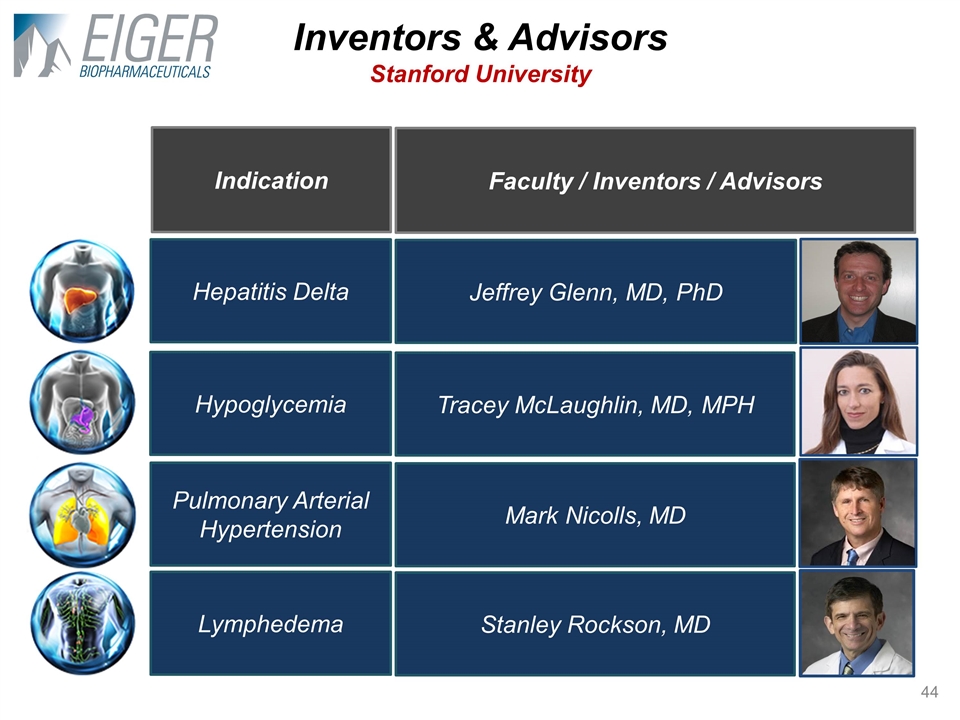
Indication Hepatitis Delta Hypoglycemia
Pulmonary Arterial Hypertension Lymphedema Inventors & Advisors Stanford University Faculty / Inventors / Advisors Jeffrey Glenn, MD, PhD Tracey McLaughlin, MD, MPH Mark Nicolls, MD Stanley Rockson, MD
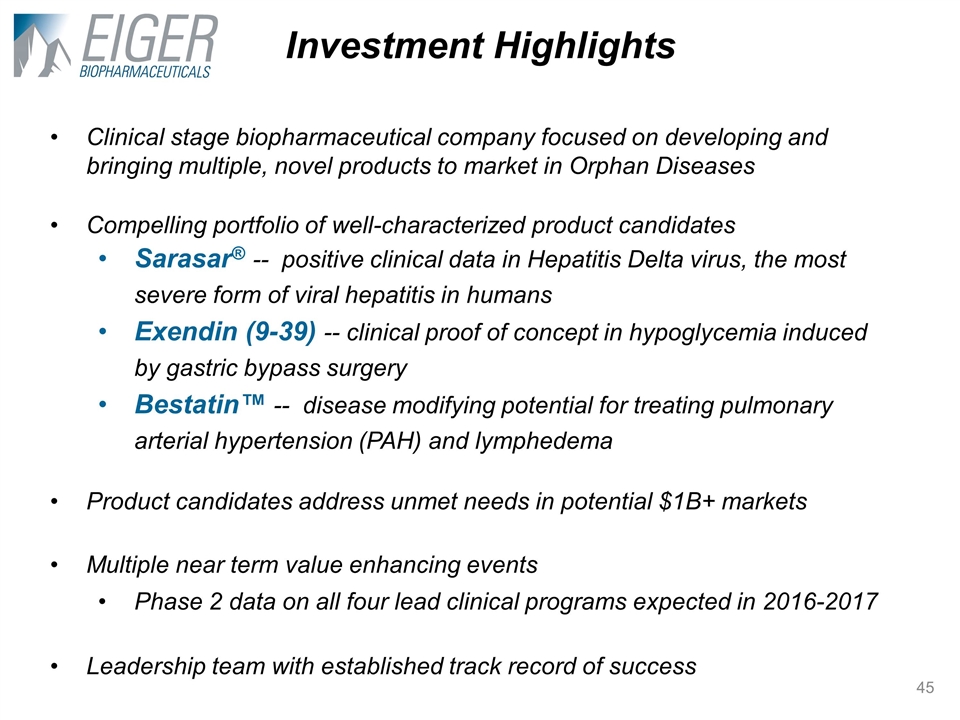
Investment Highlights Clinical stage
biopharmaceutical company focused on developing and bringing multiple, novel products to market in Orphan Diseases Compelling portfolio of well-characterized product candidates Sarasar® -- positive clinical data in Hepatitis Delta virus, the
most severe form of viral hepatitis in humans Exendin (9-39) -- clinical proof of concept in hypoglycemia induced by gastric bypass surgery Bestatin™ -- disease modifying potential for treating pulmonary arterial hypertension (PAH) and
lymphedema Product candidates address unmet needs in potential $1B+ markets Multiple near term value enhancing events Phase 2 data on all four lead clinical programs expected in 2016-2017 Leadership team with established track record of
success
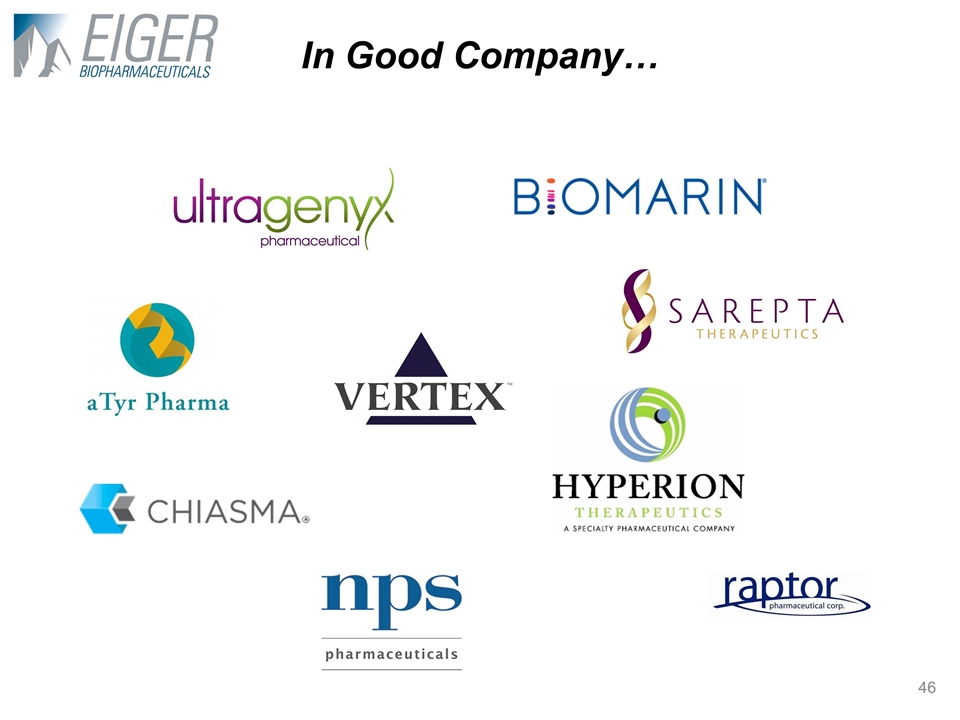
In Good Company…
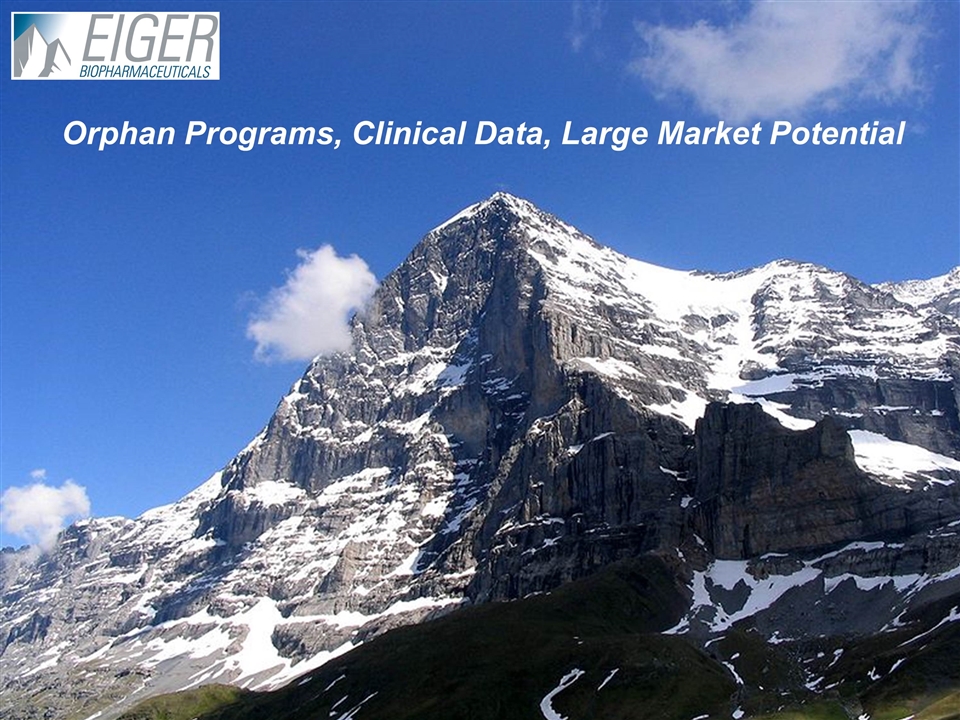
Orphan Programs, Clinical Data, Large
Market Potential
CELLADON CORP (NASDAQ:CLDN)
Historical Stock Chart
Von Jan 2025 bis Feb 2025

CELLADON CORP (NASDAQ:CLDN)
Historical Stock Chart
Von Feb 2024 bis Feb 2025


